Mathea Ford's Blog, page 6
February 12, 2025
When should someone with CKD consider a Kidney Transplant-Podcast

If you have Chronic Kidney Disease (CKD), you may be wondering when a kidney transplant is necessary and how to start the process. Kidney transplants can significantly improve the quality of life for people with advanced CKD, but knowing when to consider one and how to get on the transplant list is crucial.
For More Recipes and Ideas --->> Get Your Free Meals and Recipes That Are Perfect for Pre-Dialysis Diets, Pre-Dialysis with Diabetes, or Dialysis Diets.
In this guide, weâll break down:
â
When CKD patients should start thinking about a transplant
â
The process of getting on the transplant list
â
The option of a living donor transplant
Early discussions with your healthcare provider can help you prepare and improve your chances of a successful transplant. Letâs dive in!
When to Consider a Kidney TransplantA kidney transplant is usually considered when CKD progresses to Stage 4 or 5, meaning your kidney function has dropped below 20% of normal levels.ð¨ Key Takeaways:
You donât need to wait until you start dialysis to begin the evaluation process.The earlier you discuss transplant options with your healthcare team, the better prepared youâll be.Kidney transplants offer a long-term solution compared to dialysis, which requires ongoing treatments.If your kidney function is severely reduced, starting the evaluation early can help you move through the transplant process more smoothly.
How to Get on the Transplant ListGetting a kidney transplant involves multiple steps, including medical evaluations and finding a suitable donor. Hereâs how the process works:1. Get a ReferralYour nephrologist or primary care doctor can refer you to a transplant center for evaluation. This is the first step in determining if you qualify for a transplant.
2. Complete the Evaluation ProcessOnce referred, the transplant center will conduct medical tests to assess:
âï¸ Your overall health
âï¸ Whether you are a suitable transplant candidate
âï¸ If any other conditions need to be managed first
This step ensures that your body can handle the transplant and that no existing health conditions would interfere with the surgery or recovery.
3. Get Placed on the National Transplant Waiting ListIf you are approved, you will be placed on the national transplant waiting list. Your wait time will depend on:
ð¹ Blood type compatibility
ð¹ Matching with available donors
ð¹ Overall health status
Since kidneys from deceased donors are limited, wait times can vary from months to years. Thatâs why exploring all transplant options is essential.
Considering a Living Donor TransplantMany CKD patients shorten their wait time by exploring living donor transplants. This means receiving a kidney from:
ð¨âð©âð§ Family members
ð« Friends
ð Altruistic donors (people who donate anonymously)
â
Shorter wait time â You donât have to rely on the national transplant list.
â
Better outcomes â Living donor kidneys tend to function longer and more effectively than those from deceased donors.
â
Faster recovery â Transplants from living donors typically lead to a quicker recovery process.
If you are considering this option, discuss it with your healthcare team and loved ones to weigh the pros and cons.
Key Takeaways for CKD PatientsIf your CKD has reached Stage 4 or 5, start considering a kidney transplant.Donât wait until youâre on dialysisâbegin the evaluation process early.Talk to your doctor about getting a referral to a transplant center.Consider both the national waiting list and living donor transplants to increase your chances.Research different transplant centers to find the best fit for your needs.The right support and guidance can make your transplant journey much smoother.
A kidney transplant can offer a better quality of life for CKD patients, but early planning is crucial. If you are approaching Stage 4 or 5 CKD, talk to your doctor about getting evaluated for a transplant.
By understanding your options and working with your healthcare team, you can make informed decisions that improve your health and future.
For more kidney health resources, visit RenalDietHQ.com and stay informed about the best ways to manage CKD!
Learn more About Is Stevia Bad for Your Kidneys? The Truth Revealed-Podcast
The post When should someone with CKD consider a Kidney Transplant-Podcast appeared first on Renal Diet HQ.
February 7, 2025
Is Stevia Bad for Your Kidneys? The Truth Revealed-Podcast

If you have Chronic Kidney Disease (CKD), managing your diet is essential, especially when it comes to sugar and sweeteners. Many people turn to sugar substitutes like stevia, a natural sweetener, to reduce sugar intake without compromising taste.
But is stevia safe for CKD patients? Can it affect kidney function? In this article, weâll explore steviaâs benefits, risks, and impact on kidney health to help you make an informed choice.
For More Recipes and Ideas --->> Get Your Free Meals and Recipes That Are Perfect for Pre-Dialysis Diets, Pre-Dialysis with Diabetes, or Dialysis Diets.
Hi, Iâm Mathea Ford, a Registered Dietitian Nutritionist specializing in CKD and the founder of RenalDietHQ.com. I help people with kidney disease enjoy delicious, kidney-friendly meals that support their health. Letâs dive into whether stevia is a safe choice for those with CKD.
What is Stevia?Stevia is a natural, plant-based sweetener derived from the leaves of the Stevia rebaudiana plant. It has been used for centuries as a sugar substitute and is popular today because it is:
â
Calorie-free
â
Carbohydrate-free
â
A natural alternative to sugar
Youâll often find stevia in yogurt, cereal bars, and beverages as a healthier option compared to refined sugar. For individuals with diabetes or CKD, stevia can be especially beneficial since it does not cause blood sugar spikes.
Is Stevia Safe for People with CKD?Stevia is generally considered safe when consumed in moderation. Unlike artificial sweeteners, it is metabolized differently and does not put additional strain on the kidneys.
However, not all stevia products are created equal. Many commercial stevia products contain additives or are highly processed, which may not be suitable for CKD patients. Additionally, excessive consumption of any sweetenerânatural or artificialâcan impact overall dietary balance.
To ensure stevia is safe for your individual health needs, itâs always best to consult a dietitian or healthcare provider before adding it to your diet.
Potential Benefits of Stevia for Kidney HealthResearch suggests that stevia may have protective effects for kidney health. Some of its potential benefits include:
âï¸ Reducing inflammation caused by oxidative stress
âï¸ Supporting kidney function in small amounts
âï¸ Lowering high blood pressure and cholesterol, which are common issues for CKD patients
While these benefits sound promising, more research is needed to confirm steviaâs long-term effects on kidney health.
Nutritional Value of SteviaStevia is not just a sweetenerâit also contains some nutritional properties that may support overall health, including:
Glycosides, which provide antioxidant benefitsWater-soluble vitamins like Vitamin C and B-complex vitaminsAnti-inflammatory properties that may help regulate blood sugarBecause of these properties, stevia can be a safer alternative to traditional sweeteners like sugar or corn syrup for people with CKD. However, moderation is key.
Steviaâs Impact on Blood SugarFor CKD patientsâespecially those with diabetesâmanaging blood sugar is crucial. Many turn to artificial sweeteners, thinking they are a healthier choice.
Stevia has been found to:
â
Cause minimal changes in blood glucose and insulin levels
â
Possibly improve glycemic control over time
â
Help with weight management by reducing calorie intake
However, some studies suggest that frequent consumption of stevia may lead to elevated blood glucose levels or an increased risk of type 2 diabetes. Thatâs why moderation is essential, and individuals with diabetes should consult their healthcare provider before making stevia a regular part of their diet.
Long-Term Effects on Kidney HealthThe long-term impact of stevia on kidney health is still not fully understood. While research indicates that small amounts are safe, excessive consumption may cause:
â Bloating, nausea, dizziness, or numbness
â Potential adverse effects from highly processed stevia products
â Unknown long-term risks due to limited research
For CKD patients, itâs best to stick with pure stevia extracts rather than highly processed versions found in sweetened beverages and processed foods. Always consult your doctor before making any dietary changes.
Steviaâs Role in Managing Blood Pressure and Heart HealthOne of the biggest benefits of stevia is its potential to lower high blood pressureâa common concern for CKD patients.
In addition to blood pressure regulation, stevia may:
âï¸ Support heart health, which is crucial for CKD patients prone to cardiovascular issues
âï¸ Provide a natural, low-calorie alternative to refined sugar and artificial sweeteners
âï¸ Help reduce inflammation, which can contribute to kidney disease progression
While these benefits sound promising, excessive stevia consumption can still pose risks, so itâs best to consume it in moderation.
Risks of Overconsumption for CKD PatientsWhile stevia offers many benefits, too much of it can lead to health risksâespecially for CKD patients.
â ï¸ Hypokalemia (Low Potassium Levels): Stevia may lower potassium, leading to muscle weakness and irregular heartbeat.
â ï¸ Diuretic Properties: It may cause dehydration, which puts extra stress on the kidneys.
â ï¸ Low Blood Pressure: Since stevia naturally lowers blood pressure, combining it with other anti-hypertensive medications could cause dizziness and fatigue.
â ï¸ Impact on Gut Health: Some research suggests stevia may disrupt gut bacteria, which affects digestion and overall health.
To avoid these risks, CKD patients should only consume stevia in moderation and under medical supervision.
Final Thoughts: Should CKD Patients Use Stevia?So, is stevia bad for your kidneys? The answer is no, but moderation is key.
ð¡ Stevia can be a good sugar alternative for CKD patientsâit doesnât raise blood sugar levels, has no calories, and may offer health benefits like reducing inflammation.
ð¡ However, excessive consumption can lead to potential risks, including dehydration, potassium imbalances, and low blood pressure.
ð¡ Always consult a healthcare provider before making dietary changes to ensure stevia is safe for your specific health needs.
Stevia may be a safer alternative to sugar for CKD patients, but it should be used responsibly. While it offers benefits like blood sugar control and inflammation reduction, more research is needed to fully understand its long-term impact on kidney health.
If you have CKD, the best approach is to consume stevia in moderation, choose pure stevia extracts, and consult your doctor before making it a regular part of your diet.
For more expert advice on kidney-friendly nutrition, visit RenalDietHQ.com and take the first step toward a healthier lifestyle today!
Learn more About How does CKD lead to anemia and what can be done to treat it-Podcast
The post Is Stevia Bad for Your Kidneys? The Truth Revealed-Podcast appeared first on Renal Diet HQ.
February 5, 2025
How does CKD lead to anemia and what can be done to treat it-Podcast

Anemia is a common complication of chronic kidney disease (CKD), affecting many people as their kidney function declines. If you have CKD, you may experience fatigue, weakness, or shortness of breathâall symptoms of anemia. But why does this happen, and what can you do about it?
For More Recipes and Ideas --->> Get Your Free Meals and Recipes That Are Perfect for Pre-Dialysis Diets, Pre-Dialysis with Diabetes, or Dialysis Diets.
In this post, weâll explore:Why CKD leads to anemiaSymptoms to watch forTreatment options, including EPO therapy, iron supplements, and nutritional supportHow managing anemia can improve overall kidney healthLetâs dive in.Why Does Anemia Happen in CKD?Your kidneys play a vital role in producing a hormone called erythropoietin (EPO). This hormone signals your bone marrow to create red blood cells, which carry oxygen throughout your body.
When your kidneys are not functioning properly due to CKD, they produce less EPO. As a result, your body makes fewer red blood cells, leading to anemia.
Symptoms of Anemia in CKDIf you have CKD-related anemia, you may notice:
â
Fatigue and low energy levels
â
Weakness
â
Shortness of breath
These symptoms can significantly impact your daily life, making it essential to address anemia as part of your kidney health management.
Treatment and Management OptionsManaging anemia in CKD requires a combination of treatments. Your doctor will determine the best approach based on your specific needs.
Erythropoietin Therapy (EPO Injections)Since CKD reduces EPO production, your doctor may prescribe synthetic EPO injections. These help stimulate red blood cell production, improving oxygen delivery in your body.
Iron SupplementsIron is essential for making healthy red blood cells. If your iron levels are low, your doctor may recommend:
Oral iron supplements (pills or tablets)IV iron infusions (for those who need faster absorption)Ensuring you have enough iron can help your body respond better to EPO therapy.
Nutrition SupportCertain vitamins are crucial for red blood cell production. Make sure your diet includes:
Folate (found in leafy greens, beans, and fortified grains)Vitamin B12 (found in eggs, dairy, and fortified cereals)A well-balanced diet can support your bodyâs ability to produce red blood cells.
Treating Underlying CausesSometimes, inflammation or other health conditions can worsen anemia. Managing these underlying issues with your healthcare team can improve red blood cell levels and overall well-being.
Working with Your Healthcare TeamAnemia management is a critical part of CKD care. Your doctor may recommend a combination of EPO therapy, iron supplements, and dietary adjustments to keep your red blood cell count in a healthy range.
By addressing anemia, you can:
â Feel more energized throughout the day
â Improve oxygen circulation in your body
â Support overall kidney health
Anemia is a common issue for people with CKD, but with the right treatment plan, you can manage your symptoms and improve your quality of life.
If you found this post helpful, be sure to share it with others who may benefit! Stay informed about CKD and anemiaâyour kidney health matters.
Learn more About Low Phosphorus Meats For CKD Patients-Podcast
The post How does CKD lead to anemia and what can be done to treat it-Podcast appeared first on Renal Diet HQ.
February 1, 2025
Healthy Valentines Meal
Celebrate Love with a Kidney-Friendly Valentineâs Day Feast! This Valentineâs Day, treat your loved one to a romantic, kidney-friendly meal bursting with flavor and designed for those managing Chronic Kidney Disease (CKD). Start with Healthy Marry Me Chicken, featuring tender chicken breasts in a creamy, garlic-infused sauce made with reduced-fat cream and fresh herbs. Pair this irresistible main dish with Orzo Pilaf, a light and flavorful side prepared with orzo pasta, olive oil, and fresh parsley, and add a refreshing touch with Kale and Pomegranate Salad, a vibrant mix of kale, pomegranate seeds, and a tangy vinaigrette.
Finish your special meal on a sweet note with Healthy Date Oatmeal Bars, a delicious dessert made with wholesome oats, naturally sweet dates, and a hint of cinnamon. This thoughtful and nutritious menu is low in sodium and potassium, making it perfect for your Healthy Valentines Meal while prioritizing kidney health. Celebrate love and wellness with a feast thatâs both delicious and heartwarming! â¤ï¸
Get A Copy Of Valentines Day Meal for CKD In Your Inbox Valentines Day Meal for Two
Valentines Day Meal for TwoThis Valentineâs Day, show your love with a romantic, kidney-friendly meal thatâs as delicious as it is thoughtful. Designed for those managing Chronic Kidney Disease (CKD), this special menu is low in sodium and potassium yet full of love and flavor.
As a Registered Dietitian Nutritionist specializing in Chronic Kidney Disease (CKD) and the owner of RenalDietHQ.com, I am dedicated to empowering individuals to manage their kidney health through practical, evidence-based nutrition guidance. With years of experience in creating kidney-friendly meal plans and resources, I focus on helping those with CKD enjoy flavorful, balanced diets that support their overall well-being. Every recipe and dietary recommendation shared here is thoughtfully designed to meet the unique needs of individuals managing CKD, ensuring a healthier, more fulfilling lifestyle.
Healthy Marry Me Chicken, Start your meal, a tender, flavorful dish featuring juicy chicken breasts in a creamy, kidney-friendly sauce made with garlic, reduced-fat cream, and fresh herbs. This heartwarming entrée will make anyone fall in love all over again.
Orzo Pilaf, Bright, zesty, and kidney-friendly, Orzo Pilaf with Lemon and Dill is a delightful medley of fresh flavors! Crafted with low-sodium ingredients and a perfect hint of citrus, this dish makes a wholesome, flavorful side that complements any CKD diet.
Kale and Pomegranate Salad, is a vibrant, nutrient-packed option for a CKD-friendly diet. With its low sodium and potassium content, it's perfect for supporting kidney health while delivering heart-healthy fats, fiber, and antioxidants. The combination of tender kale and juicy pomegranate seeds creates a flavorful, wholesome dish that's as satisfying as it is nourishing for those managing chronic kidney disease.
Healthy Date Oatmeal Bars, Indulge in the wholesome goodness of Healthy Date Oatmeal Bars! Packed with natural sweetness from dates, heart-healthy oats, and a hint of warmth from cinnamon, these bars are a perfect snack or breakfast treat. Nourishing and kidney-friendly, they're a delicious way to fuel your day while supporting a CKD-conscious diet.
Celebrate love and good health this Valentineâs Day with this kidney-friendly menu thatâs sure to impress your special someone
Check Out Our Meal Plans For People With Chronic Kidney Disease (CKD)Recent Kidney Friendly Recipes Healthy Valentines Meal
Healthy Valentines Meal Healthy Marry Me Chicken
Healthy Marry Me Chicken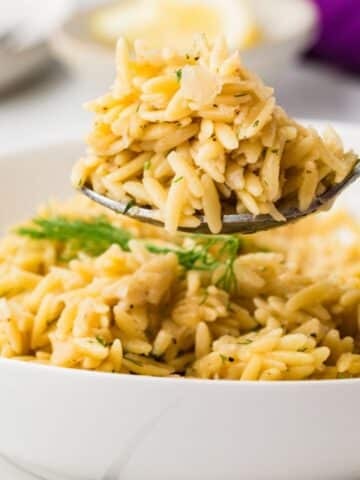 Orzo Pilaf
Orzo Pilaf Healthy Oatmeal Date Bars
Healthy Oatmeal Date BarsHealthy Marry Me Chicken
Orzo Pilaf
Kale and Pomegranate Salad
Healthy Oatmeal Date Bars
The post Healthy Valentines Meal appeared first on Renal Diet HQ.
January 31, 2025
Low Phosphorus Meats For CKD Patients-Podcast

Living with chronic kidney disease (CKD) requires careful management of your diet, especially when it comes to phosphorus intake. Excess phosphorus can cause complications like weak bones and cardiovascular issues. However, CKD patients can still enjoy a variety of low-phosphorus meats while maintaining their health. In this guide, weâll explore the best options for a kidney-friendly diet.
For More Recipes and Ideas --->> Get Your Free Meals and Recipes That Are Perfect for Pre-Dialysis Diets, Pre-Dialysis with Diabetes, or Dialysis Diets.
Why Phosphorus Matters for CKDThe kidneys play a crucial role in filtering excess phosphorus from the blood. When kidney function declines, phosphorus can accumulate, leading to serious health issues such as:
Bone and Joint Problems â High phosphorus levels weaken bones and increase the risk of fractures.Heart Disease â Excess phosphorus can cause calcium deposits in blood vessels, leading to heart problems.Mineral Imbalances â Elevated phosphorus affects calcium and vitamin D levels, which are essential for overall health.Because of these risks, CKD patients are advised to follow a low-phosphorus diet to maintain a healthy balance in their bodies.
Sources of Dietary PhosphorusPhosphorus is found in many foods, including:
Meat, Poultry, and Fish â Some animal proteins naturally contain phosphorus, but the levels vary.Dairy Products â Milk, cheese, and yogurt are high in phosphorus.Legumes, Nuts, and Whole Grains â Plant-based sources contain phosphorus, but in a form that is less absorbable by the body.Processed and Packaged Foods â Many processed foods contain phosphorus additives, which are highly absorbable and should be avoided.To effectively manage phosphorus intake, CKD patients should read food labels carefully and opt for fresh, minimally processed foods.
Best Low-Phosphorus Meats for CKDChoosing the right meats can help CKD patients maintain protein intake while keeping phosphorus levels in check. Some of the best low-phosphorus meat options include:
1. Skinless Chicken BreastA lean source of protein with lower phosphorus levels compared to dark meat.Best prepared by grilling, baking, or steaming to maintain nutritional value.2. Freshwater FishOptions like tilapia, canned tuna in water, and catfish have lower phosphorus levels than saltwater fish.Fish is also a great source of heart-healthy omega-3 fatty acids.3. Turkey Breast CutletsSkinless, lean cuts provide high-quality protein with a lower phosphorus content.Avoid pre-seasoned or processed turkey, as it may contain phosphorus additives.4. Extra Lean Ground BeefLower in phosphorus than fattier cuts and processed meats.Choosing fresh, unprocessed beef over deli meats or pre-marinated options is best.5. Pork Tenderloin MedallionsA leaner cut of pork that offers good protein without excessive phosphorus.Best cooked by roasting or grilling with kidney-friendly seasonings.6. Peeled ShrimpA great seafood choice with relatively low phosphorus levels.Opt for fresh or frozen shrimp without additives.These meats provide essential protein while keeping phosphorus intake within safe limits for CKD patients.
Factors Affecting Phosphorus Levels in FoodUnderstanding what influences phosphorus levels in food can help CKD patients make better dietary choices:
Cooking Methods â Boiling and steaming help reduce phosphorus content in meat.Processing and Additives â Prepackaged and marinated meats often contain phosphorus additives, which should be avoided.Absorption Rates â Animal-based phosphorus is more easily absorbed than plant-based sources, making portion control essential.Phosphorus Binders â Some CKD patients may take phosphorus binders to limit absorption; consult a doctor for guidance.Comparing Phosphorus Levels in MeatHereâs a comparison of phosphorus content in 3 oz cooked portions of different meats:
Beef Pot Roast â 155 mgSkinless Chicken Breast â 190 mgLean Ground Beef â 170 mgFish (Canned Tuna, Mahi-Mahi, Shrimp) â Varies, but generally lower in phosphorusBy choosing meats with lower phosphorus levels, CKD patients can enjoy a balanced diet while protecting their kidney health.
Tips for Cooking and Seasoning Low-Phosphorus MeatsUse Kidney-Friendly Cooking Methods â Boiling, steaming, baking, and grilling help reduce phosphorus content.Choose Natural Seasonings â Herbs like garlic powder, oregano, basil, paprika, and cumin add flavor without extra phosphorus.Avoid Processed Meats â Deli meats, frozen dinners, and pre-marinated meats often contain phosphorus additives.Alternatives to Meat for Lower Phosphorus IntakeFor those looking to reduce meat consumption while maintaining protein intake, consider these kidney-friendly options:
Legumes (Beans, Lentils) â Good sources of plant-based protein with lower phosphorus absorption rates.Whole Grains (Quinoa, Oats, Brown Rice) â Nutritious and kidney-friendly.Nuts (Almonds, Walnuts, Cashews, Pistachios) â Provide healthy fats and omega-3s in small portions.Vegetarian Meals â Tofu stir-fry, eggplant Parmesan, and other plant-based dishes add variety to a CKD diet.Balancing Protein and Phosphorus for CKD HealthManaging phosphorus intake is essential for CKD patients to prevent complications. By choosing low-phosphorus meats and incorporating plant-based proteins, individuals can maintain good nutrition while supporting kidney health. Working with a dietitian can help tailor a meal plan that meets individual needs, ensuring a balanced and kidney-friendly diet.
With the right choices, CKD patients can enjoy delicious and nutritious meals while prioritizing their health!
Learn more About Why is bone health so important in CKD-Podcast
The post Low Phosphorus Meats For CKD Patients-Podcast appeared first on Renal Diet HQ.
January 29, 2025
Why is bone health so important in CKD-Podcast

Bone health is a crucial yet often overlooked aspect of living with Chronic Kidney Disease (CKD). If you're managing CKD, understanding how it impacts your bonesâand what you can do to protect themâis vital. Letâs dive into why bone health matters for kidney patients and how to keep your bones strong.
For More Recipes and Ideas --->> Get Your Free Meals and Recipes That Are Perfect for Pre-Dialysis Diets, Pre-Dialysis with Diabetes, or Dialysis Diets.
Why Are Bones at Risk with CKD?Kidney function plays a key role in maintaining the balance of minerals like calcium and phosphorus in your body. When your kidneys arenât working properly, they can't regulate these minerals effectively. This imbalance can cause your body to pull calcium from your bones, leading to bone weakness.
Additionally, CKD affects the hormones responsible for bone growth and maintenance. These hormonal changes can make your bones even more fragile over time, increasing the risk of fractures and other bone-related issues. That's why taking steps to protect your bones is so important when managing CKD.
How to Protect Your Bones with CKDFortunately, there are several steps you can take to safeguard your bones while managing CKD. Hereâs what you can do:
1. Maintain Phosphorus Levels
High phosphorus levels in your blood can harm your bones, leading to further weakening. Keeping phosphorus in check is essential for bone health.
What can you do?
2. Ensure Adequate Calcium & Vitamin D
Calcium and vitamin D are crucial for maintaining bone strength. CKD can interfere with your ability to absorb calcium properly, which is why your doctor may recommend supplements.
What should you do?
A balanced CKD-friendly diet isnât just about controlling phosphorus and calcium levelsâitâs also about ensuring youâre getting the right nutrients without overdoing things like sodium, potassium, or phosphorus.
What should you focus on?
By choosing kidney-friendly foods and maintaining a balanced diet, you can help your bones stay as strong as possible while managing CKD.
Staying Active for Stronger BonesExercise isnât just good for your heart and musclesâitâs also essential for your bones. Regular physical activity, particularly low-impact exercises like walking or light strength training, can help maintain bone strength.
What should you keep in mind?
Some people with CKD may need medications to help balance key hormones, such as parathyroid hormone (PTH), which plays a big role in bone health.
Why is this important?
Working closely with your kidney care team is key to protecting both your kidneys and bones. Regular follow-up appointments and blood tests allow your doctor to monitor your mineral levels and adjust your treatment plan as needed.
Why is this important?
By following these steps, you can protect your bones while living with CKD. Managing your phosphorus levels, ensuring adequate calcium and vitamin D intake, staying active, and collaborating with your healthcare team will all help maintain stronger bones and a healthier body.
Remember, taking care of your bones is just as important as taking care of your kidneys. Together, these steps can contribute to a healthier, stronger life despite CKD.
Protecting Bone Health with CKD: Key TakeawaysKeep phosphorus levels in check by following a CKD-friendly diet.Consult your doctor about calcium and vitamin D supplements.Stay active with low-impact exercises to maintain bone strength.Ask your doctor about medications to balance hormones that affect bones.Regular check-ups with your healthcare team are vital to monitor bone health.By staying proactive and working closely with your medical team, you can help protect your bones while managing CKD. For more tips on kidney and bone health, be sure to follow along for future updates.
Learn more About Dining Out with Kidney Disease Eat Smart Stay Healthy-Podcast
The post Why is bone health so important in CKD-Podcast appeared first on Renal Diet HQ.
January 23, 2025
Healthy Marry Me Chicken
Discover a delicious, easy-to-make chicken dish designed for beginners thatâs gentle on your kidneys and perfect for healthy living. This Healthy Marry Me Chicken recipe is perfect for those following a CKD-friendly diet, offering lean protein, flavorful seasonings, and creamy textures without the excess sodium or potassium.
Plus, it's designed with simplicity in mind, ensuring that even beginners can create a nutritious meal without hassle. Give this recipe a try, and enjoy a tasty dish that's gentle on your kidneys while supporting your health goals.
Having grown up with both parents managing chronic kidney disease, I understand firsthand the dietary challenges faced by those with CKD. With over 25 years of experience as a Registered Dietitian, I have made it my mission to create kidney-friendly recipes that are not only healthy but also delicious and easy to prepare.
My expertise in crafting meals that align with current guidelines is evident in this "Marry Me Chicken" recipe, which uses ingredients like reduced-fat cream cheese and low-sodium chicken broth to minimize sodium and unhealthy fats. This approach reflects best practices in CKD management, ensuring that those living with kidney disease can enjoy flavorful meals while maintaining their health.

This Easy Marry Me Chicken recipe is designed with kidney health in mind, featuring lean protein from chicken breast and low-sodium ingredients like reduced-fat cream cheese and chicken broth. With heart-healthy olive oil, antioxidant-rich spinach, and a blend of flavorful herbs, this dish provides essential nutrients while keeping sodium and potassium in check, making it a perfect choice for those managing Chronic Kidney Disease.
You can eat this marry me chicken with some of our kidney friendly salads, like the kale and pomegranate salad or the delicious salad with cornbread. We even have a spicy cucumber salad that might make your tastebuds sizzle.
[feast_advanced_jump_to]Ingredients for One Pan Marry Me ChickenLooking for an easy and healthy take on the beloved "marry me chicken" recipe? This one-pan dish combines flavorful ingredients with a lighter twist to create a meal that's both delicious and nutritious.
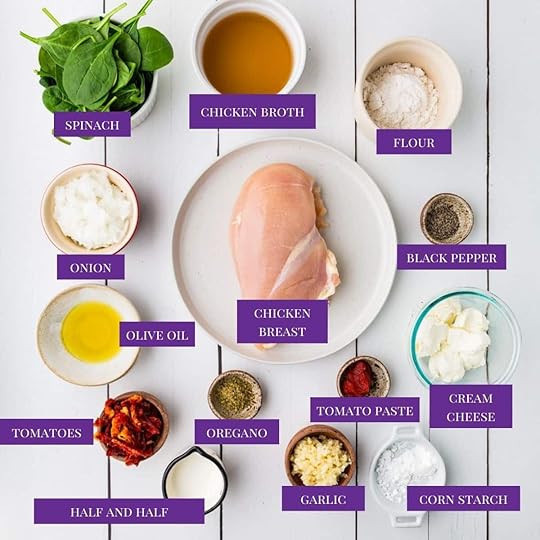 Chicken breast: A lean source of high-quality protein, ideal for supporting muscle maintenance without contributing to excess fat intake, which is crucial for kidney health.Black pepper: Enhances flavor without sodium, making it a great seasoning choice for individuals looking to manage their salt intake.All-purpose flour: Lightly coats the chicken to create a crispy texture while keeping the dish low in fat and kidney-friendly.Olive oil: A heart-healthy fat that helps reduce inflammation and supports overall health, beneficial for kidney disease management.Onion: Provides natural sweetness and flavor while being a low-potassium vegetable, making it safe for those managing CKD.Garlic: Known for its potential to help lower blood pressure and improve heart health, both important factors for kidney function.Tomato paste: Adds rich flavor with minimal potassium, offering a concentrated taste without overwhelming the dish with sodium.Sundried tomatoes (dry, not in oil): Intensifies the flavor while offering antioxidants and nutrients in a concentrated form, but with less sodium than oil-packed varieties.Baby spinach: A kidney-friendly leafy green that is low in potassium and high in vitamins and antioxidants, supporting overall kidney health.Reduced-fat cream cheese: Provides a creamy texture without excess saturated fat, making it a lighter option for a kidney-friendly diet.Low-sodium chicken broth: Adds flavor and moisture without contributing to high sodium intake, which is important for kidney disease management.Half and half: Adds creaminess to the dish while keeping fat content in check, which is ideal for maintaining a heart-healthy and kidney-friendly meal.Cornstarch: Used as a thickener to create a smooth sauce without adding unnecessary sodium or potassium, keeping the dish balanced for CKD.Dried oregano: A flavorful herb with antioxidant properties that adds depth to the sauce while promoting kidney and overall health.
Chicken breast: A lean source of high-quality protein, ideal for supporting muscle maintenance without contributing to excess fat intake, which is crucial for kidney health.Black pepper: Enhances flavor without sodium, making it a great seasoning choice for individuals looking to manage their salt intake.All-purpose flour: Lightly coats the chicken to create a crispy texture while keeping the dish low in fat and kidney-friendly.Olive oil: A heart-healthy fat that helps reduce inflammation and supports overall health, beneficial for kidney disease management.Onion: Provides natural sweetness and flavor while being a low-potassium vegetable, making it safe for those managing CKD.Garlic: Known for its potential to help lower blood pressure and improve heart health, both important factors for kidney function.Tomato paste: Adds rich flavor with minimal potassium, offering a concentrated taste without overwhelming the dish with sodium.Sundried tomatoes (dry, not in oil): Intensifies the flavor while offering antioxidants and nutrients in a concentrated form, but with less sodium than oil-packed varieties.Baby spinach: A kidney-friendly leafy green that is low in potassium and high in vitamins and antioxidants, supporting overall kidney health.Reduced-fat cream cheese: Provides a creamy texture without excess saturated fat, making it a lighter option for a kidney-friendly diet.Low-sodium chicken broth: Adds flavor and moisture without contributing to high sodium intake, which is important for kidney disease management.Half and half: Adds creaminess to the dish while keeping fat content in check, which is ideal for maintaining a heart-healthy and kidney-friendly meal.Cornstarch: Used as a thickener to create a smooth sauce without adding unnecessary sodium or potassium, keeping the dish balanced for CKD.Dried oregano: A flavorful herb with antioxidant properties that adds depth to the sauce while promoting kidney and overall health.See recipe card for quantities.
How To Make Marry Me Chicken HealthyGet ready to make a delicious and light chicken recipe with a rich, creamy sauce and vibrant vegetables. By following these simple steps, you'll have a flavorful dish that's sure to impress.
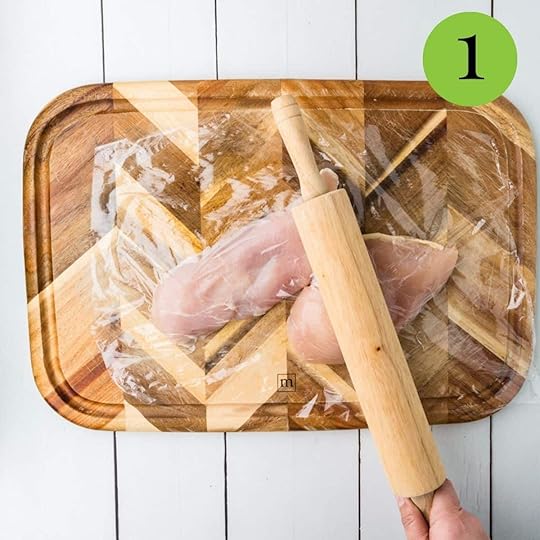 Begin by pounding the chicken breasts to an even thickness, about ½ in thick. Place the chicken breasts in a plastic bag, and use a rolling pin to pound the breasts into an even thickness.
Begin by pounding the chicken breasts to an even thickness, about ½ in thick. Place the chicken breasts in a plastic bag, and use a rolling pin to pound the breasts into an even thickness. 
2. Season with pepper, and dredge each piece in flour, shaking off any excess. Set aside. Heat ½ tablespoon olive oil in a large skillet over medium high heat. Add the chicken and cook for 5-6 minutes per side or until the chicken is cooked through and has a golden brown crust. Remove the chicken from the skillet and set aside.
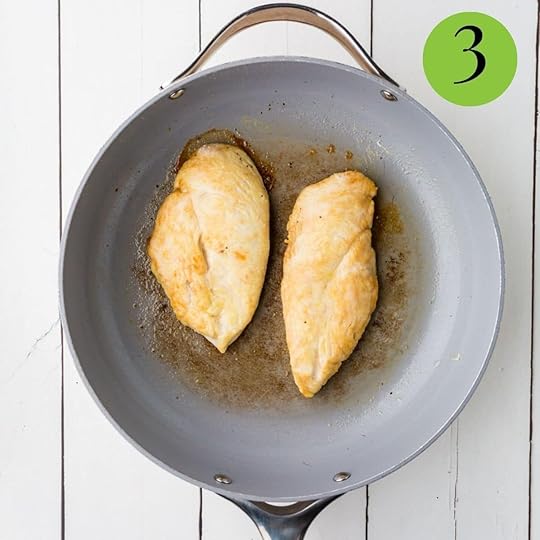 Heat ½ tablespoon olive oil in a large skillet over medium high heat. Add the chicken and cook for 5-6 minutes per side or until the chicken is cooked through and has a golden brown crust. Remove the chicken from the skillet and set aside.
Heat ½ tablespoon olive oil in a large skillet over medium high heat. Add the chicken and cook for 5-6 minutes per side or until the chicken is cooked through and has a golden brown crust. Remove the chicken from the skillet and set aside.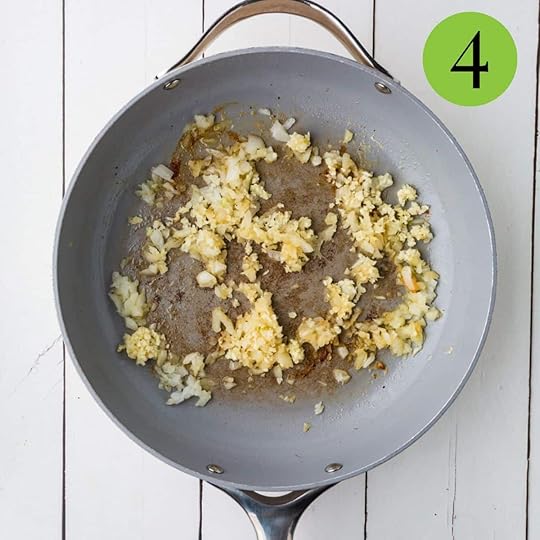 In the same skillet, add the remaining ½ tablespoon of olive oil. Add the diced onion and saute for 3 minutes, then add the minced garlic and saute for another 1 minute.
In the same skillet, add the remaining ½ tablespoon of olive oil. Add the diced onion and saute for 3 minutes, then add the minced garlic and saute for another 1 minute.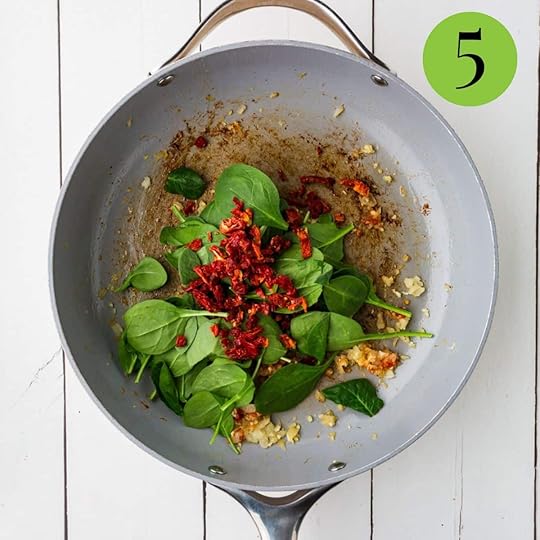
5. Stir in the tomato paste and cook for another 2-3 minutes. Add the chopped sundried tomatoes and the baby spinach to the skillet. Cook until the spinach wilts, about 4-5 minutes.
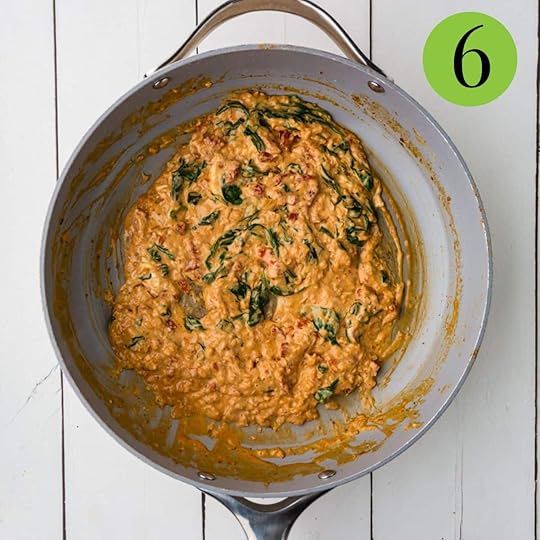
6. Reduce the heat to low. Add the cornstarch to the half and half and stir to combine. Add the cornstarch mixture, cream cheese, chicken broth and oregano to the skillet. Stiru until the cream cheese is fully melted and the sauce is well combined, about 4-5 minutes.
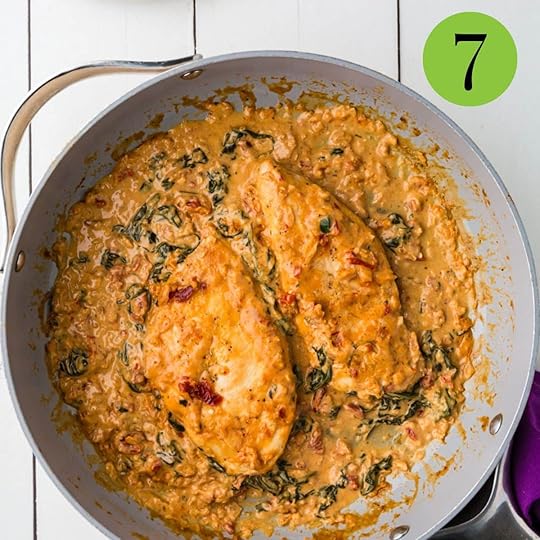
7. Add the cooked chicken back to the skillet and simmer in the sauce for 4-5 minutes until the chicken is heated through.
8. Serve chicken with sauce.
Hint: Pounding the Chicken: Ensure the chicken breasts are pounded evenly to avoid overcooking or uneven textures. This helps the chicken cook more evenly and quickly.
Substitutions in Low Carb Marry Me ChickenIf you need to adjust this recipe to better suit your taste or dietary preferences, here are some kidney-friendly substitutions:
Low-Sodium Broth Substitute: If you prefer a richer flavor, use homemade low-sodium vegetable broth instead of chicken broth to keep sodium levels low.Chicken Breast Substitute: Swap the chicken for lean turkey breast or even tofu for a plant-based alternative.Olive Oil Substitute: If olive oil isn't your favorite, avocado oil is another healthy fat that works well for sautéing and cooking.Variations for Healthy Ways To Make ChickenThis healthy Marry Me Chicken recipe is a flavorful twist on the classic dish, perfect for a delicious and nourishing meal. With a focus on balanced ingredients and ease of preparation, this recipe is ideal for anyone looking to enjoy a healthy version of a flavorful chicken dish.
Dairy-Free Option: For a dairy-free alternative, try using a plant-based cream cheese to maintain the creamy texture without the dairySpinach Substitute: Swap the spinach for other low-potassium greens like kale or arugula.Add Veggies: Include kidney-friendly vegetables like zucchini or bell peppers for extra flavor and nutrients. Storage Ideas For One Pan Healthy Marry Me Chicken
Storage Ideas For One Pan Healthy Marry Me ChickenTo keep this Healthy Marry Me Chicken fresh and maintain its CKD-friendly qualities, follow these storage tips:
Reheating: When reheating, add a splash of low-sodium chicken broth or half and half to restore the creamy texture and prevent it from drying out. Heat over low to medium heat, stirring occasionally.Refrigeration: Store any leftover chicken and sauce in an airtight container in the refrigerator for up to 3-4 days. Be sure to allow the dish to cool to room temperature before refrigerating to maintain its texture.Freezing: If you'd like to make a larger batch for future meals, you can freeze the cooked chicken and sauce in a freezer-safe container for up to 2 months. When ready to enjoy, thaw overnight in the fridge and reheat gently on the stove.Top TipMake Ahead: Organize your cooking by having all ingredients ready before you start. Dice the onions, mince the garlic, and measure both dry and wet ingredients. This preparation allows you to focus on cooking without pausing to measure while the pan is hot.FAQs For Best Marry Me ChickenCan I use chicken thighs instead of chicken breasts?Yes, you can use chicken thighs instead of breasts. Opt for skinless and trimmed thighs to keep the recipe CKD-friendly, but note that thighs may require a slightly longer cooking time.
What can I serve this dish with to keep it kidney-friendly?Pair the dish with a kidney friendly side dish or steamed low-potassium vegetables like green beans or cauliflower, or serve over a small portion of white rice for a balanced meal.
Are there other herbs or spices I can add to enhance the flavor?Yes, you can add fresh basil or parsley for a burst of freshness or a pinch of smoked paprika for a subtle smoky depth while keeping the recipe CKD-friendly.
Looking for other recipes like this? Try these:
 Healthy Marry Me Chicken
Healthy Marry Me Chicken Chicken and Broccoli with Cashews
Chicken and Broccoli with Cashews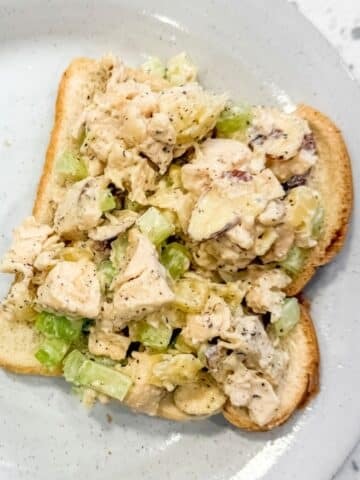 Hawaiian Chicken Salad
Hawaiian Chicken Salad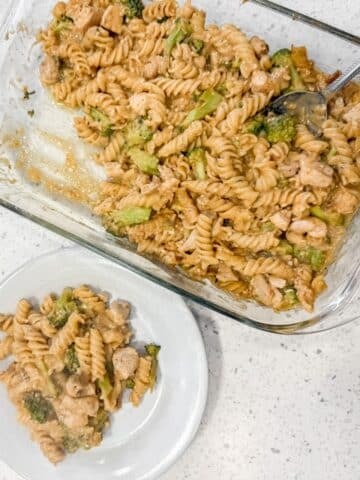 Chicken and Broccoli Pasta BakePairing with Marry Me Chicken
Chicken and Broccoli Pasta BakePairing with Marry Me ChickenThese are my favorite dishes to serve with your kidney friendly chicken entree:
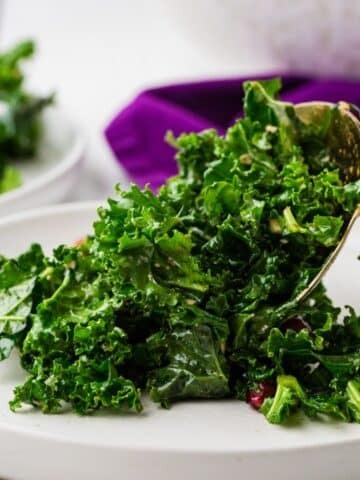 Kale and Pomegranate Salad
Kale and Pomegranate Salad Corn Pasta Salad
Corn Pasta Salad Cornbread Salad
Cornbread Salad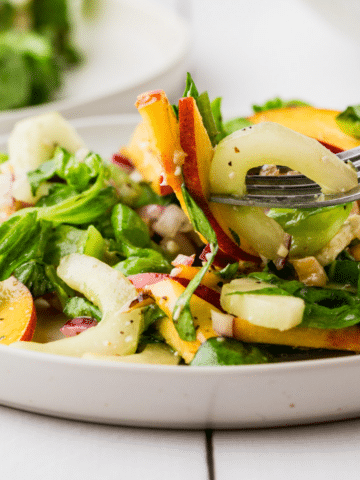 Nectarine Salad
Nectarine SaladIf you tried this Recipe or any other recipe on my website, please please leave a star rating and let me know how it goes in the comments below. I love hearing from you!
Recipe PrintMarry Me Chicken Healthy Recipe#wprm-recipe-user-rating-0 .wprm-rating-star.wprm-rating-star-full svg * { fill: #343434; }#wprm-recipe-user-rating-0 .wprm-rating-star.wprm-rating-star-33 svg * { fill: url(#wprm-recipe-user-rating-0-33); }#wprm-recipe-user-rating-0 .wprm-rating-star.wprm-rating-star-50 svg * { fill: url(#wprm-recipe-user-rating-0-50); }#wprm-recipe-user-rating-0 .wprm-rating-star.wprm-rating-star-66 svg * { fill: url(#wprm-recipe-user-rating-0-66); }linearGradient#wprm-recipe-user-rating-0-33 stop { stop-color: #343434; }linearGradient#wprm-recipe-user-rating-0-50 stop { stop-color: #343434; }linearGradient#wprm-recipe-user-rating-0-66 stop { stop-color: #343434; }#wprm-recipe-user-rating-0.wprm-user-rating-allowed.wprm-user-rating-not-voted:not(.wprm-user-rating-voting) svg * { fill-opacity: 0.3; }This healthy version of Marry Me Chicken features tender chicken breasts cooked to perfection and enriched with a flavorful sauce made of sundried tomatoes, spinach, and a touch of cream. Easy to make in under 30 minutes, this dish combines wholesome ingredients for a delicious meal your family will love. Course Entree, Main CourseCuisine AmericanDiet Diabetic, Low Fat, Low SaltPrep Time 10 minutes minutesCook Time 35 minutes minutesTotal Time 45 minutes minutesServings 2Calories 326kcalAuthor Mathea Ford, RDN, LD, MBAEquipment1 SkilletIngredients6 ounces chicken breast¼ teaspoon black pepper¼ cup all purpose flour1 tablespoon olive oil½ cup finely diced onion2 tablespoon minced garlic1 teaspoon tomato paste2 tablespoon sundried tomatoes dry (not in oil)1 cup baby spinach2 tablespoon reduced fat cream cheese½ cup low sodium chicken broth2 tablespoon half and half½ teaspoon corn starch½ teaspoon dried oreganoGet ingredients with
PrintMarry Me Chicken Healthy Recipe#wprm-recipe-user-rating-0 .wprm-rating-star.wprm-rating-star-full svg * { fill: #343434; }#wprm-recipe-user-rating-0 .wprm-rating-star.wprm-rating-star-33 svg * { fill: url(#wprm-recipe-user-rating-0-33); }#wprm-recipe-user-rating-0 .wprm-rating-star.wprm-rating-star-50 svg * { fill: url(#wprm-recipe-user-rating-0-50); }#wprm-recipe-user-rating-0 .wprm-rating-star.wprm-rating-star-66 svg * { fill: url(#wprm-recipe-user-rating-0-66); }linearGradient#wprm-recipe-user-rating-0-33 stop { stop-color: #343434; }linearGradient#wprm-recipe-user-rating-0-50 stop { stop-color: #343434; }linearGradient#wprm-recipe-user-rating-0-66 stop { stop-color: #343434; }#wprm-recipe-user-rating-0.wprm-user-rating-allowed.wprm-user-rating-not-voted:not(.wprm-user-rating-voting) svg * { fill-opacity: 0.3; }This healthy version of Marry Me Chicken features tender chicken breasts cooked to perfection and enriched with a flavorful sauce made of sundried tomatoes, spinach, and a touch of cream. Easy to make in under 30 minutes, this dish combines wholesome ingredients for a delicious meal your family will love. Course Entree, Main CourseCuisine AmericanDiet Diabetic, Low Fat, Low SaltPrep Time 10 minutes minutesCook Time 35 minutes minutesTotal Time 45 minutes minutesServings 2Calories 326kcalAuthor Mathea Ford, RDN, LD, MBAEquipment1 SkilletIngredients6 ounces chicken breast¼ teaspoon black pepper¼ cup all purpose flour1 tablespoon olive oil½ cup finely diced onion2 tablespoon minced garlic1 teaspoon tomato paste2 tablespoon sundried tomatoes dry (not in oil)1 cup baby spinach2 tablespoon reduced fat cream cheese½ cup low sodium chicken broth2 tablespoon half and half½ teaspoon corn starch½ teaspoon dried oreganoGet ingredients with  InstructionsBegin by pounding the chicken breasts to an even thickness, about ½ in thick. Place the chicken breasts in a plastic bag, and use a rolling pin to pound the breasts into an even thickness. Season with pepper, and dredge each piece in flour, shaking off any excess. Set aside.Heat ½ tablespoon olive oil in a large skillet over medium high heat. Add the chicken and cook for 5-6 minutes per side or until the chicken is cooked through and has a golden brown crust. Remove the chicken from the skillet and set aside.In the same skillet, add the remaining ½ tablespoon of olive oil. Add the diced onion and saute for 3 minutes, then add the minced garlic and saute for another 1 minute.Stir in the tomato paste and cook for another 2-3 minutes.Add the chopped sundried tomatoes and the baby spinach to the skillet. Cook until the spinach wilts, about 4-5 minutes.Reduce the heat to low. Add the cornstarch to the half and half and stir to combine. Add the cornstarch mixture, cream cheese, chicken broth and oregano to the skillet. Stir until the cream cheese is fully melted and the sauce is well combined, about 4-5 minutes.Add the cooked chicken back to the skillet and simmer in the sauce for 4-5 minutes until the chicken is heated through.Serve chicken with sauce.Videohttps://youtu.be/-nkLP6Ea7ZkNutritionCalories: 326kcal | Carbohydrates: 26g | Protein: 25g | Fat: 14g | Saturated Fat: 4g | Polyunsaturated Fat: 2g | Monounsaturated Fat: 7g | Trans Fat: 0.01g | Cholesterol: 68mg | Sodium: 224mg | Potassium: 825mg | Fiber: 3g | Sugar: 6g | Vitamin A: 1669IU | Vitamin C: 13mg | Vitamin D: 0.1µg | Calcium: 101mg | Iron: 3mg | Phosphorus: 303mgCheck Out Our Meal Plans For People With Chronic Kidney Disease (CKD)
InstructionsBegin by pounding the chicken breasts to an even thickness, about ½ in thick. Place the chicken breasts in a plastic bag, and use a rolling pin to pound the breasts into an even thickness. Season with pepper, and dredge each piece in flour, shaking off any excess. Set aside.Heat ½ tablespoon olive oil in a large skillet over medium high heat. Add the chicken and cook for 5-6 minutes per side or until the chicken is cooked through and has a golden brown crust. Remove the chicken from the skillet and set aside.In the same skillet, add the remaining ½ tablespoon of olive oil. Add the diced onion and saute for 3 minutes, then add the minced garlic and saute for another 1 minute.Stir in the tomato paste and cook for another 2-3 minutes.Add the chopped sundried tomatoes and the baby spinach to the skillet. Cook until the spinach wilts, about 4-5 minutes.Reduce the heat to low. Add the cornstarch to the half and half and stir to combine. Add the cornstarch mixture, cream cheese, chicken broth and oregano to the skillet. Stir until the cream cheese is fully melted and the sauce is well combined, about 4-5 minutes.Add the cooked chicken back to the skillet and simmer in the sauce for 4-5 minutes until the chicken is heated through.Serve chicken with sauce.Videohttps://youtu.be/-nkLP6Ea7ZkNutritionCalories: 326kcal | Carbohydrates: 26g | Protein: 25g | Fat: 14g | Saturated Fat: 4g | Polyunsaturated Fat: 2g | Monounsaturated Fat: 7g | Trans Fat: 0.01g | Cholesterol: 68mg | Sodium: 224mg | Potassium: 825mg | Fiber: 3g | Sugar: 6g | Vitamin A: 1669IU | Vitamin C: 13mg | Vitamin D: 0.1µg | Calcium: 101mg | Iron: 3mg | Phosphorus: 303mgCheck Out Our Meal Plans For People With Chronic Kidney Disease (CKD)The post Healthy Marry Me Chicken appeared first on Renal Diet HQ.
January 22, 2025
Orzo Pilaf
A kidney-friendly recipe tailored for beginnersâinfusing zesty flavors and simplicity into your meal prep.
If you're looking for a simple yet flavorful side dish that fits within a kidney-friendly diet, look no further than this easy Lemon-Dill Orzo Pilaf. Living with kidney disease presents dietary challenges, as it's crucial to reduce sodium and maintain balanced nutrition without compromising on taste. This vibrant orzo pilaf offers a refreshing solution with its zesty combination of lemon and dill, alongside the comforting texture of orzo pasta.
Having grown up in a family affected by chronic kidney disease (CKD), I deeply understand the challenges of crafting meals that are both delicious and kidney-friendly. With over 25 years as a Registered Dietitian, I combine my professional expertise and personal experiences to create nutrient-rich recipes, like this Lemon-Dill Orzo Pilaf, designed to fit seamlessly into CKD dietary plans.
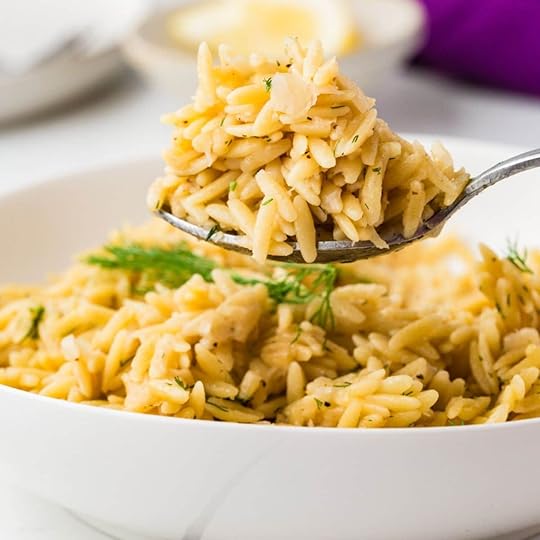
This Orzo Pilaf with Lemon and Dill is crafted with low-sodium ingredients, making it a safe and flavorful choice for those managing Chronic Kidney Disease (CKD). The use of orzo pasta, fresh herbs, and lemon zest ensures a vibrant, satisfying dish that is low in potassium and free from high-sodium seasonings. Itâs a perfect side dish that balances nutrition and taste while adhering to CKD dietary guidelines.
Looking for other kidney friendly side dishes? This orzo pilaf goes well with a pomegranate salad and some healthy date bars for dessert. You also would love the healthy version of marry me chicken that is just one of our renal diet chicken entrees! But don't stop there - try it with some low sodium cornbread and corn salad!
[feast_advanced_jump_to]Ingredients in Orzo Pilaf PastaThis Orzo Pilaf combines simple, wholesome ingredients like orzo pasta, fresh herbs, and zesty lemon to create a vibrant and kidney-friendly side dish. Each ingredient is carefully chosen to enhance the dishâs flavor while keeping it light and suitable for those with CKD.
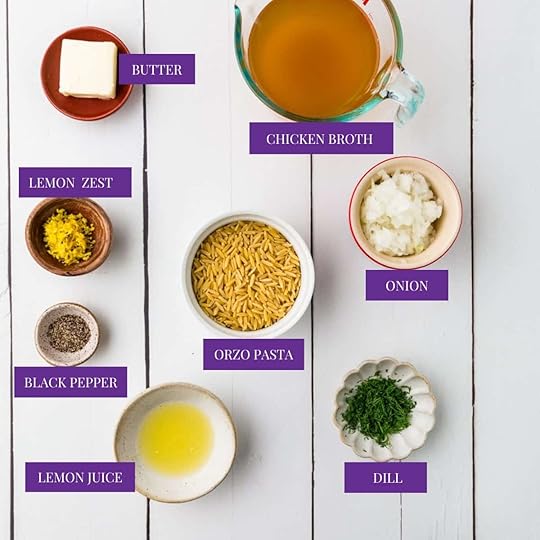 Butter â Adds a rich, creamy texture to the dish without introducing extra sodium, making it suitable for a kidney-friendly diet.White Onion â Provides a natural sweetness and depth of flavor, enhancing the dish while being low in potassium.Orzo Pasta â A small pasta shape that cooks quickly and serves as a hearty, lower-potassium alternative to other grains.Lemon Zest â Delivers bright, fresh citrus flavor without adding extra liquid or sodium.Lemon Juice â Adds a tangy, refreshing acidity that balances the dish and enhances the herbal notes.Low Sodium Chicken Broth â Provides a savory, flavorful base without the high sodium content of traditional broths.Black Pepper â Offers a mild heat and a flavor boost, helping to season the dish without salt.Fresh Chopped Dill â Adds a fragrant, herbaceous finish, complementing the lemon and creating a vibrant flavor profile.
Butter â Adds a rich, creamy texture to the dish without introducing extra sodium, making it suitable for a kidney-friendly diet.White Onion â Provides a natural sweetness and depth of flavor, enhancing the dish while being low in potassium.Orzo Pasta â A small pasta shape that cooks quickly and serves as a hearty, lower-potassium alternative to other grains.Lemon Zest â Delivers bright, fresh citrus flavor without adding extra liquid or sodium.Lemon Juice â Adds a tangy, refreshing acidity that balances the dish and enhances the herbal notes.Low Sodium Chicken Broth â Provides a savory, flavorful base without the high sodium content of traditional broths.Black Pepper â Offers a mild heat and a flavor boost, helping to season the dish without salt.Fresh Chopped Dill â Adds a fragrant, herbaceous finish, complementing the lemon and creating a vibrant flavor profile.See recipe card for quantities.
How To Make Vegetarian Orzo PilafGet ready to elevate your meal with a delicious and zesty orzo pilaf! Follow these simple steps to create a flavorful dish that's perfect as a side or on its own.
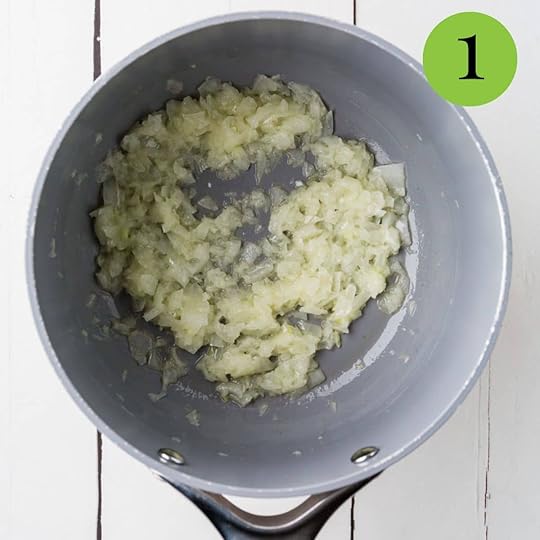 In a medium pot with a lid, melt 2 tablespoon butter over medium heat. Add the chopped onion and saute over medium heat until softened, about 3 minutes.
In a medium pot with a lid, melt 2 tablespoon butter over medium heat. Add the chopped onion and saute over medium heat until softened, about 3 minutes.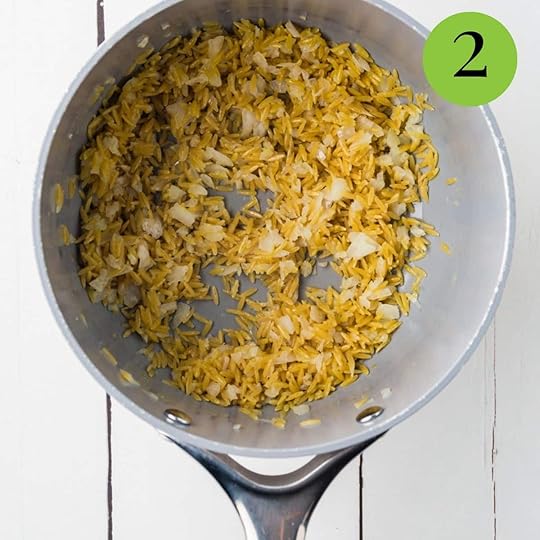 Add the orzo and lemon zest, and stir to combine. Continue to cook for another 3-4 minutes until orzo is slightly toasted.
Add the orzo and lemon zest, and stir to combine. Continue to cook for another 3-4 minutes until orzo is slightly toasted.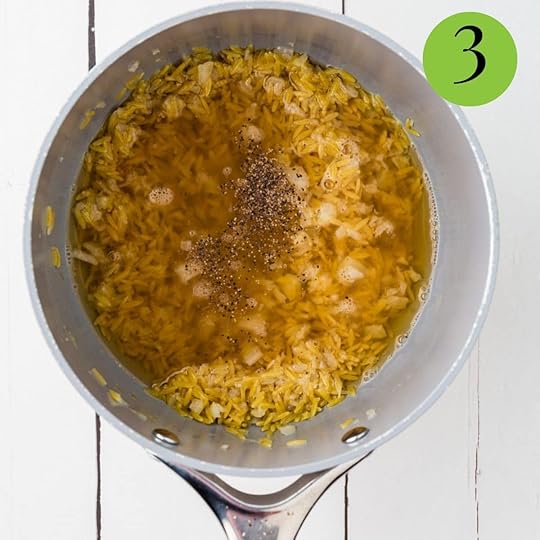 Add the chicken broth and the black pepper. Bring to a boil, then cover and simmer on low until all liquid is absorbed - about 12 minutes. For the last 5 minutes of cooking, remove the lid and keep it at a simmer.
Add the chicken broth and the black pepper. Bring to a boil, then cover and simmer on low until all liquid is absorbed - about 12 minutes. For the last 5 minutes of cooking, remove the lid and keep it at a simmer.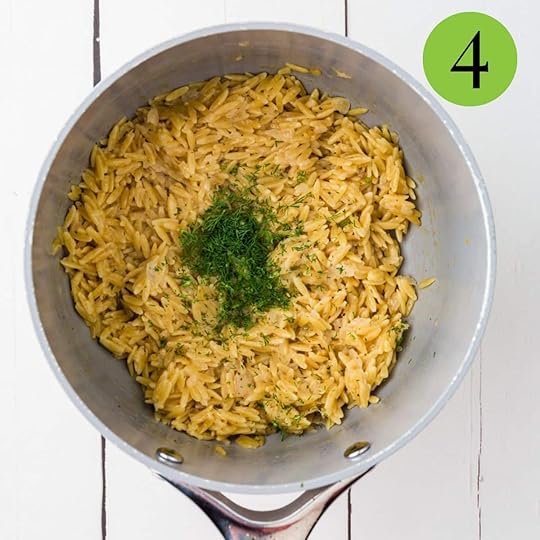 Turn off the heat and stir in the lemon juice and the chopped dill. Stir to combine well.
Turn off the heat and stir in the lemon juice and the chopped dill. Stir to combine well.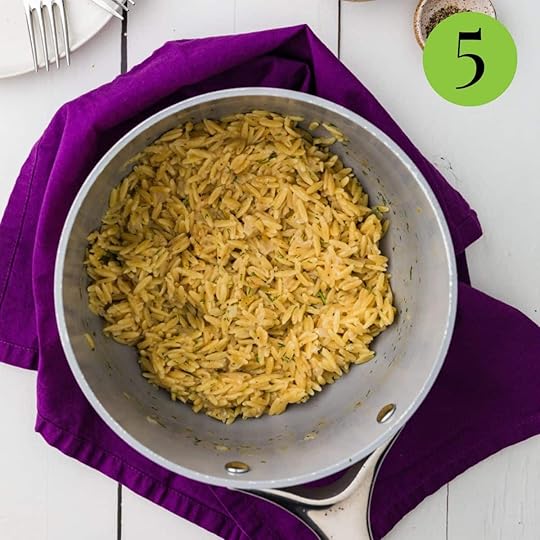
5. Serve with a garnish of fresh dill or lemon slices.
Hint: Substitute for Broth - For a vegetarian-friendly version, substitute the chicken broth with vegetable broth. It maintains the depth of flavor while keeping the dish plant-based.
Substitutions for Easy Orzo PilafHerbed orzo pilaf is a delightful and simple side dish that's perfect for bringing a burst of fresh flavor to your meals. The combination of lemon and dill creates a vibrant and aromatic dish, making it a great accompaniment to a variety of main courses. For those following a kidney-friendly diet, here are some substitutions to make this recipe more suitable for CKD-friendly needs:
Orzo Pasta: If you prefer a gluten-free option, substitute with quinoa or brown rice for a different texture and flavor profile.Butter: Use olive oil or avocado oil for a heart-healthy, plant-based fat alternative.Low Sodium Chicken Broth: Swap in homemade vegetable broth for a lighter, lower-sodium option.Variations for Orzo Pilaf RecipeOrzo pilaf is a delightful side dish that brings a touch of sophistication and flavor to any meal. With its delicate blend of citrus and herbs, this dish pairs well with a variety of main courses while being simple enough to prepare. Below are some variations to make this recipe suitable for those following a kidney-friendly diet.
Protein Boost: Add grilled chicken breast, shrimp, or tofu for a protein-packed meal that still follows CKD guidelines.Vegetarian Option: Skip the chicken broth and replace it with vegetable broth for a fully plant-based dish.Add Vegetables: Consider adding kidney-friendly veggies like spinach, zucchini, or bell peppers to increase the nutrient content.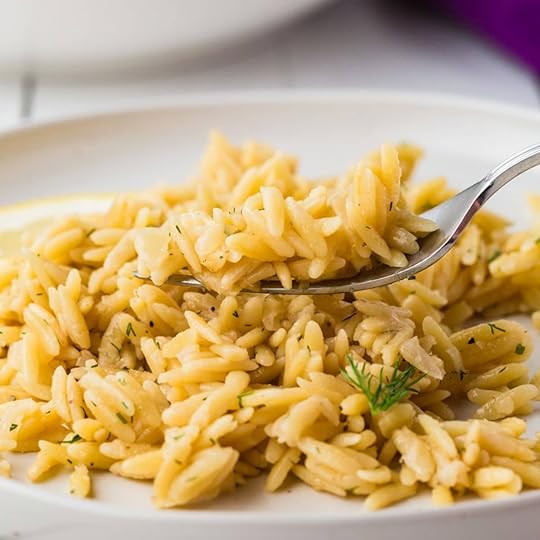 Storage for Herbed Orzo Pilaf
Storage for Herbed Orzo PilafTo keep your Orzo Pilaf with Lemon and Dill fresh and maintain its CKD-friendly qualities, follow these storage tips:
Avoid Overheating: When reheating, avoid overheating as it can cause the orzo to become overly soft. Reheat gently over low heat to retain the best texture and flavor.Refrigeration: Store leftovers in an airtight container in the refrigerator for up to 3-4 days. This helps preserve the dishâs flavor and freshness while keeping it safe to consume.Freezing: If you have extra portions, you can freeze the pilaf for up to 1-2 months. Let it cool completely before placing it in a freezer-safe container or zip-top bag. To reheat, thaw overnight in the fridge and reheat in the microwave or on the stove with a splash of water or broth.Top Tip for Orzo Rice PilafEnhance Flavor with Herbs: For extra flavor, add a sprig of rosemary or thyme during cooking and remove before serving. These herbs complement the lemon and dill beautifully.FAQs about Orzo As A Side DishCan I make this recipe ahead of time?Yes, this Orzo Pilaf can be made ahead of time and stored in the refrigerator for up to 3-4 days. It also tastes great when served cold, making it perfect for meal prep.
Is orzo pasta kidney-friendly?Yes, orzo pasta is relatively low in potassium and can be a suitable choice for those with CKD when used in moderation. Just be sure to monitor portion sizes and pair it with kidney-friendly ingredients like low-sodium broth.
How can I make this dish more filling?If youâd like to make the dish more filling, consider adding grilled chicken, tofu, or a kidney-friendly protein like shrimp. You can also toss in some extra vegetables like zucchini, bell peppers, or spinach for added texture and nutrition.
Looking for other recipes like this? Try these:
 Orzo Pilaf
Orzo Pilaf Parmesan Carrots
Parmesan Carrots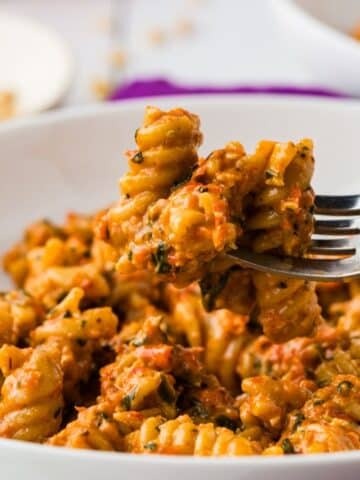 Roasted Red Pepper Pesto Pasta
Roasted Red Pepper Pesto Pasta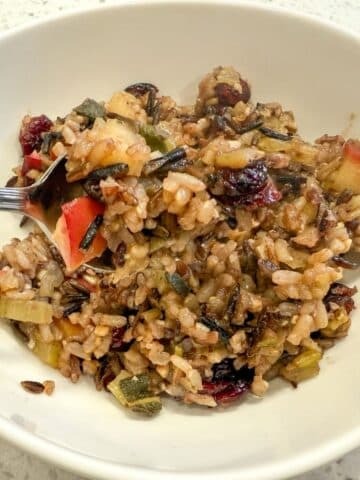 Wild Rice StuffingPairing with Easy Orzo Side Dish
Wild Rice StuffingPairing with Easy Orzo Side DishThese are my favorite dishes to serve with Orzo Pilaf:
 Healthy Oatmeal Date Bars
Healthy Oatmeal Date Bars Vegetarian Sloppy Joes
Vegetarian Sloppy Joes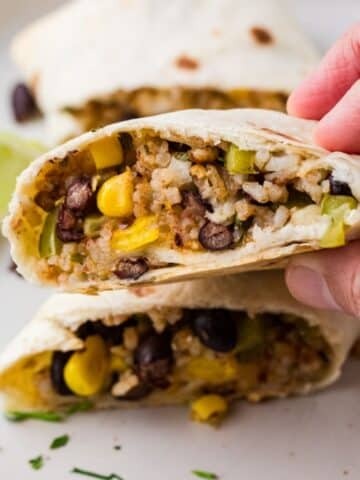 Black Bean and Rice Burrito
Black Bean and Rice Burrito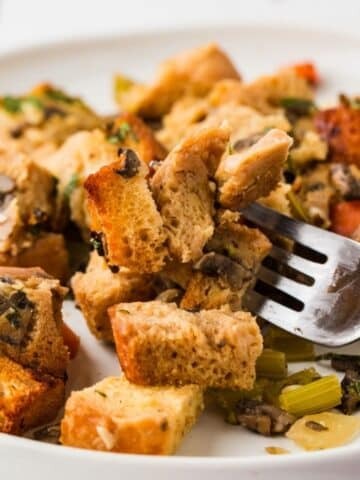 Vegetable Stuffing
Vegetable StuffingIf you tried this Recipe or any other recipe on my website, please please leave a star rating and let me know how it goes in the comments below. I love hearing from you!
Recipe PrintEasy Rice Pilaf with Orzo#wprm-recipe-user-rating-1 .wprm-rating-star.wprm-rating-star-full svg * { fill: #343434; }#wprm-recipe-user-rating-1 .wprm-rating-star.wprm-rating-star-33 svg * { fill: url(#wprm-recipe-user-rating-1-33); }#wprm-recipe-user-rating-1 .wprm-rating-star.wprm-rating-star-50 svg * { fill: url(#wprm-recipe-user-rating-1-50); }#wprm-recipe-user-rating-1 .wprm-rating-star.wprm-rating-star-66 svg * { fill: url(#wprm-recipe-user-rating-1-66); }linearGradient#wprm-recipe-user-rating-1-33 stop { stop-color: #343434; }linearGradient#wprm-recipe-user-rating-1-50 stop { stop-color: #343434; }linearGradient#wprm-recipe-user-rating-1-66 stop { stop-color: #343434; }#wprm-recipe-user-rating-1.wprm-user-rating-allowed.wprm-user-rating-not-voted:not(.wprm-user-rating-voting) svg * { fill-opacity: 0.3; }This orzo pilaf is a flavorful and easy dish that pairs perfectly with any meal. Sautéed onions, lemon zest, and fresh dill bring vibrant flavors to toasted orzo cooked in chicken broth, resulting in a delightful and aromatic side dish.Course Side Dish, SnackCuisine AmericanDiet Diabetic, Low Fat, Low Lactose, Low SaltPrep Time 5 minutes minutesCook Time 20 minutes minutesTotal Time 25 minutes minutesServings 2Calories 279kcalAuthor Mathea Ford, RDN, LD, MBAEquipment1 SkilletIngredients2 tablespoon butter½ cup finely diced white onion½ cup orzo pasta1 tablespoon lemon zest from one lemon1 tablespoon lemon juice1 cups low sodium chicken broth½ teaspoon black pepper1 tablespoon fresh chopped dillGet ingredients with
PrintEasy Rice Pilaf with Orzo#wprm-recipe-user-rating-1 .wprm-rating-star.wprm-rating-star-full svg * { fill: #343434; }#wprm-recipe-user-rating-1 .wprm-rating-star.wprm-rating-star-33 svg * { fill: url(#wprm-recipe-user-rating-1-33); }#wprm-recipe-user-rating-1 .wprm-rating-star.wprm-rating-star-50 svg * { fill: url(#wprm-recipe-user-rating-1-50); }#wprm-recipe-user-rating-1 .wprm-rating-star.wprm-rating-star-66 svg * { fill: url(#wprm-recipe-user-rating-1-66); }linearGradient#wprm-recipe-user-rating-1-33 stop { stop-color: #343434; }linearGradient#wprm-recipe-user-rating-1-50 stop { stop-color: #343434; }linearGradient#wprm-recipe-user-rating-1-66 stop { stop-color: #343434; }#wprm-recipe-user-rating-1.wprm-user-rating-allowed.wprm-user-rating-not-voted:not(.wprm-user-rating-voting) svg * { fill-opacity: 0.3; }This orzo pilaf is a flavorful and easy dish that pairs perfectly with any meal. Sautéed onions, lemon zest, and fresh dill bring vibrant flavors to toasted orzo cooked in chicken broth, resulting in a delightful and aromatic side dish.Course Side Dish, SnackCuisine AmericanDiet Diabetic, Low Fat, Low Lactose, Low SaltPrep Time 5 minutes minutesCook Time 20 minutes minutesTotal Time 25 minutes minutesServings 2Calories 279kcalAuthor Mathea Ford, RDN, LD, MBAEquipment1 SkilletIngredients2 tablespoon butter½ cup finely diced white onion½ cup orzo pasta1 tablespoon lemon zest from one lemon1 tablespoon lemon juice1 cups low sodium chicken broth½ teaspoon black pepper1 tablespoon fresh chopped dillGet ingredients with  InstructionsIn a medium pot with a lid, melt 2 tablespoon butter over medium heat. Add the chopped onion and saute over medium heat until softened, about 3 minutes.Add the orzo and lemon zest, and stir to combine. Continue to cook for another 3-4 minutes until orzo is slightly toasted.Add the chicken broth and the black pepper. Bring to a boil, then cover and simmer on low until all liquid is absorbed - about 12 minutes. For the last 5 minutes of cooking, remove the lid and keep it at a simmer.Turn off the heat and stir in the lemon juice and the chopped dill. Stir to combine well.Serve with a garnish of fresh dill or lemon slices.Videohttps://youtu.be/ccQ1dmz1uAQNutritionCalories: 279kcal | Carbohydrates: 34g | Protein: 8g | Fat: 13g | Saturated Fat: 8g | Polyunsaturated Fat: 1g | Monounsaturated Fat: 3g | Trans Fat: 0.5g | Cholesterol: 30mg | Sodium: 130mg | Potassium: 268mg | Fiber: 2g | Sugar: 3g | Vitamin A: 371IU | Vitamin C: 10mg | Calcium: 32mg | Iron: 1mg | Phosphorus: 123mgCheck Out Our Meal Plans For People With Chronic Kidney Disease (CKD)
InstructionsIn a medium pot with a lid, melt 2 tablespoon butter over medium heat. Add the chopped onion and saute over medium heat until softened, about 3 minutes.Add the orzo and lemon zest, and stir to combine. Continue to cook for another 3-4 minutes until orzo is slightly toasted.Add the chicken broth and the black pepper. Bring to a boil, then cover and simmer on low until all liquid is absorbed - about 12 minutes. For the last 5 minutes of cooking, remove the lid and keep it at a simmer.Turn off the heat and stir in the lemon juice and the chopped dill. Stir to combine well.Serve with a garnish of fresh dill or lemon slices.Videohttps://youtu.be/ccQ1dmz1uAQNutritionCalories: 279kcal | Carbohydrates: 34g | Protein: 8g | Fat: 13g | Saturated Fat: 8g | Polyunsaturated Fat: 1g | Monounsaturated Fat: 3g | Trans Fat: 0.5g | Cholesterol: 30mg | Sodium: 130mg | Potassium: 268mg | Fiber: 2g | Sugar: 3g | Vitamin A: 371IU | Vitamin C: 10mg | Calcium: 32mg | Iron: 1mg | Phosphorus: 123mgCheck Out Our Meal Plans For People With Chronic Kidney Disease (CKD)The post Orzo Pilaf appeared first on Renal Diet HQ.
January 21, 2025
Healthy Oatmeal Date Bars
These Healthy Oatmeal Date Bars are the perfect sweet treat for anyone following a CKD-friendly diet. Packed with nutrient-rich ingredients like dates, oats, and cinnamon, they provide a natural sweetness and wholesome flavor without overwhelming your kidneys. Enjoy these delicious bars as a satisfying snack that supports your health while catering to your dietary needs.
As a Registered Dietitian specializing in chronic kidney disease (CKD), I am dedicated to helping individuals make informed, health-conscious choices to improve their well-being. With years of experience working with CKD patients, I provide evidence-based nutrition advice tailored to each person's unique needs. My expertise ensures that the recipes and dietary guidance I share are safe, practical, and aligned with the latest research for managing kidney health.
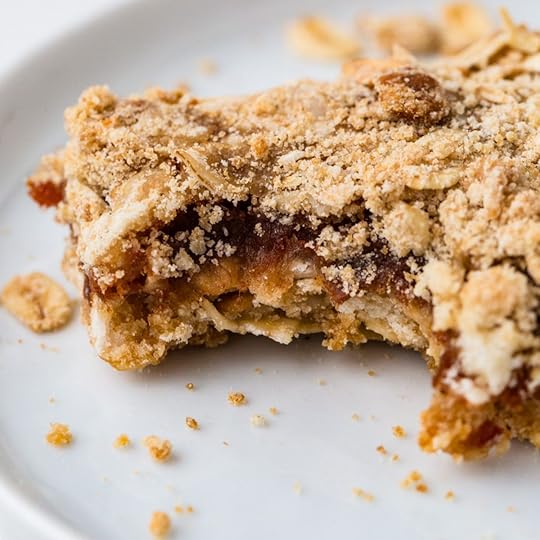
These healthy date oatmeal bars are designed with CKD dietary needs in mind, using ingredients that are low in sodium and potassium while providing fiber and natural sweetness. The dates offer a heart-healthy alternative to refined sugars, while oats help regulate blood sugar levels, making this recipe a safe and delicious snack option for those managing kidney disease.
Are you looking for more kidney friendly desserts? We have strawberry rhubarb bars as well as vegan apple cake. And what's more, these go perfectly with a kale and pomegranate salad that you can enjoy all year long.
[feast_advanced_jump_to]Ingredients for Healthy Oatmeal BarsThis recipe for Healthy Oatmeal Date Bars uses simple, wholesome ingredients that come together to create a delicious, CKD-friendly treat. From the naturally sweet dates to the heart-healthy oats, each ingredient plays a vital role in making these bars both nutritious and satisfying.
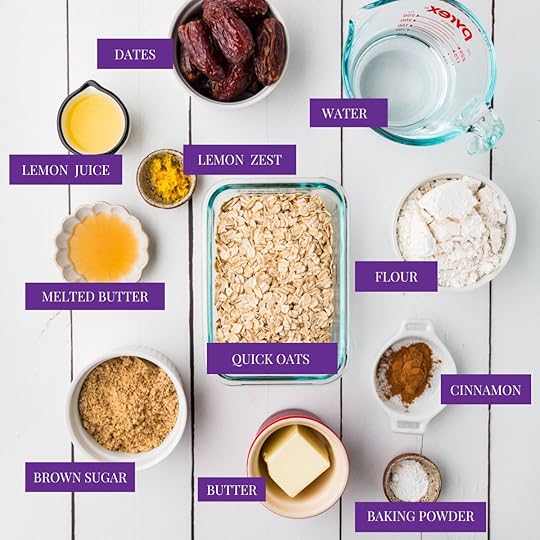 Dried dates: Naturally sweet and rich in fiber, offering a healthier alternative to refined sugars.Water: Essential for hydration and achieving the right consistency without adding sodium or potassium.Lemon juice: Provides tangy flavor and vitamin C, supporting immune health and iron absorption.Cinnamon: Enhances flavor with antioxidant and anti-inflammatory benefits.Lemon zest: Adds bright, citrusy flavor with no extra sodium or potassium.Quick oats: A great source of fiber that supports heart health and regulates blood sugar levels.Flour: Offers structure and texture while being low in sodium and CKD-friendly.Brown sugar: Provides natural sweetness with a mild molasses flavor, used sparingly for balance.Honey: A natural sweetener with antioxidants, preferable to processed sugars.Melted butter: Adds richness and flavor with healthy fats when used in moderation.Baking powder: Helps the bars rise and provides a light texture; use low-sodium baking powder to make it CKD-friendly.
Dried dates: Naturally sweet and rich in fiber, offering a healthier alternative to refined sugars.Water: Essential for hydration and achieving the right consistency without adding sodium or potassium.Lemon juice: Provides tangy flavor and vitamin C, supporting immune health and iron absorption.Cinnamon: Enhances flavor with antioxidant and anti-inflammatory benefits.Lemon zest: Adds bright, citrusy flavor with no extra sodium or potassium.Quick oats: A great source of fiber that supports heart health and regulates blood sugar levels.Flour: Offers structure and texture while being low in sodium and CKD-friendly.Brown sugar: Provides natural sweetness with a mild molasses flavor, used sparingly for balance.Honey: A natural sweetener with antioxidants, preferable to processed sugars.Melted butter: Adds richness and flavor with healthy fats when used in moderation.Baking powder: Helps the bars rise and provides a light texture; use low-sodium baking powder to make it CKD-friendly.See recipe card for quantities.
How To Make Healthy Date Bars with OatmealNow that you have all the ingredients ready, it's time to bring them together in a few simple steps. Follow the instructions below to create these delicious, CKD-friendly oatmeal date bars that are perfect for any occasion.
 Preheat oven to 350'FPlace dates, water, lemon juice, cinnamon and lemon zest into a medium saucepan. Bring to a boil. Boil for at least 10 minutes until the dates break down.
Preheat oven to 350'FPlace dates, water, lemon juice, cinnamon and lemon zest into a medium saucepan. Bring to a boil. Boil for at least 10 minutes until the dates break down.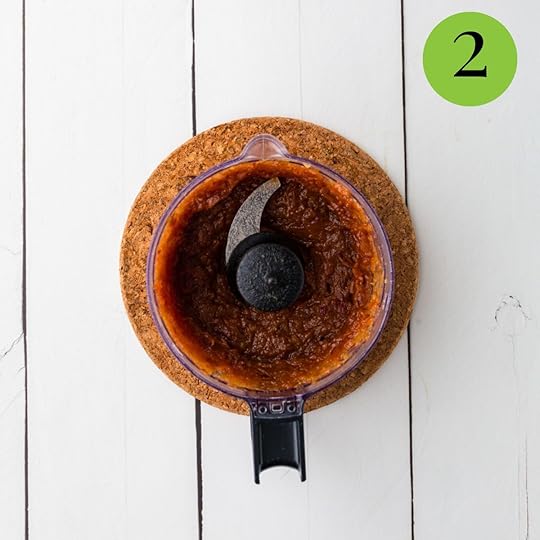
3. Use a hand held blender (or regular blender) to puree the dates once cooked so they are smooth.
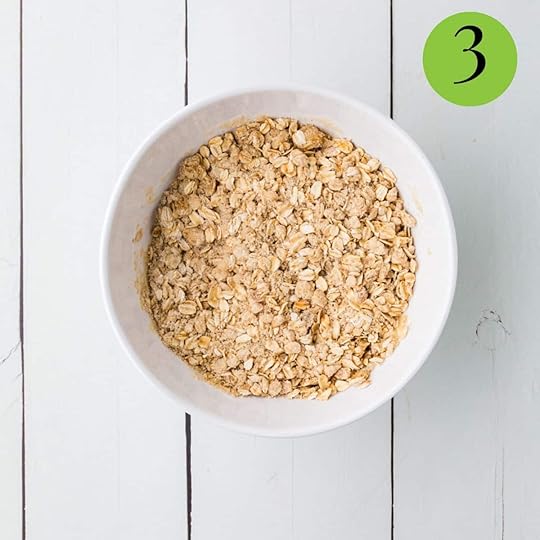
4. Place oats, flour, brown sugar, honey, butter and baking powder into a medium sized bowl and mix well.
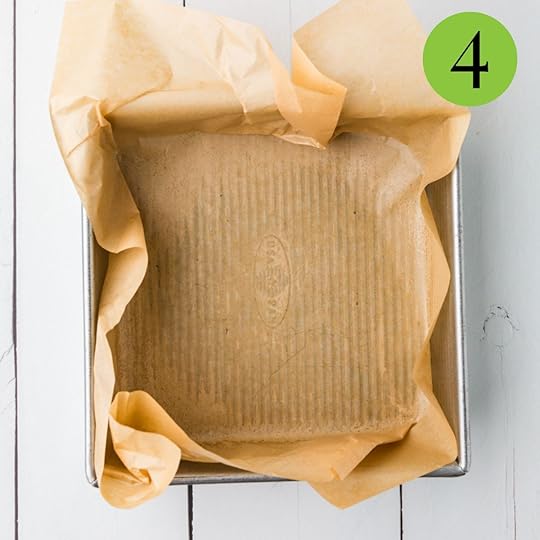
5. Spray an 8x8 in pan and line with parchment paper.
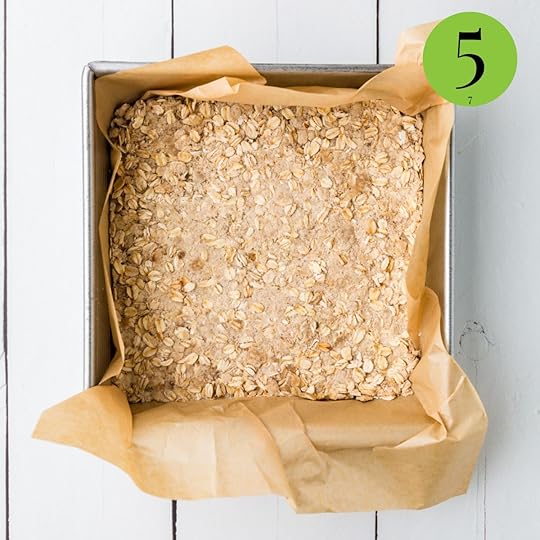
6. Pour half the oat mixture into the bottom of the pan and gently push it down.
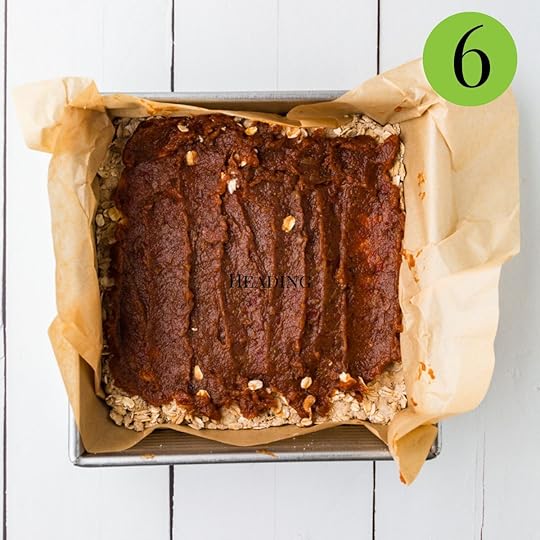
7. Pour the date mixture on top and use a spatula to spread it evenly over the bottom crisp.
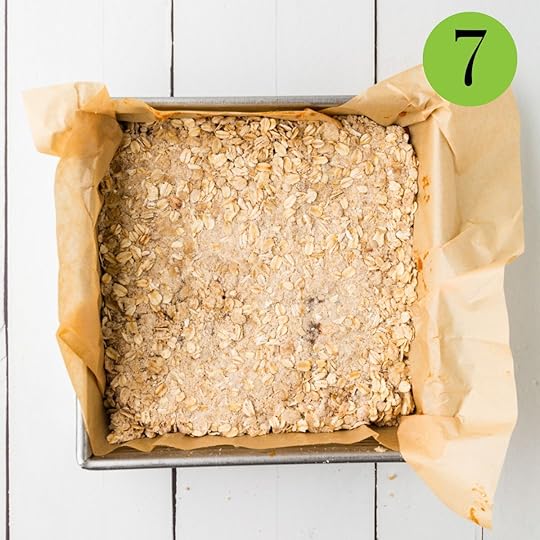
8. Add remaining oat mixture on top of the date filling and gently press it down.
9. Bake for 35 minutes. Cut into 8 pieces
Hint: Check for Doneness: After 35 minutes, check the bars by gently pressing the top; if itâs firm and golden brown, theyâre ready. Let them cool completely before cutting to avoid crumbling.
Substitutions For Healthy Oatmeal BarsThere are several substitutions that can be made to better suit specific dietary needs while still keeping the recipe tasty and kidney-friendly:
Flour: Swap the all-purpose flour for a whole wheat flour or oat flour to boost the fiber content in these bars, which is great for kidney health.Honey: If you prefer to avoid honey, substitute with maple syrup for a natural, slightly different sweetness.Butter: For a dairy-free option, use coconut oil or olive oil instead of butter to maintain the richness.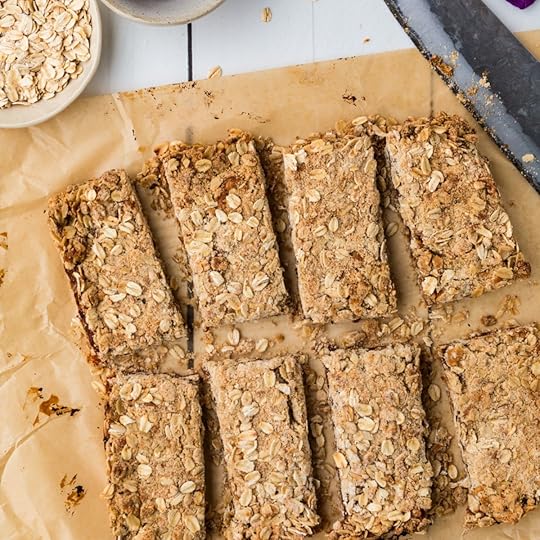 Variations in Healthy Date Bars With Oatmeal
Variations in Healthy Date Bars With OatmealIf you'd like to customize this recipe further, here are a few variations that are still kidney-friendly and can suit different tastes or dietary needs:
Dried Fruit: Swap the dates for other CKD-friendly dried fruits like raisins or apricots for a new twist on this recipe.Add Nuts: Mix in a small handful of chopped walnuts or almonds to add a bit of crunch and healthy fats.Spiced Up: For a different flavor, try adding a pinch of ginger or nutmeg along with the cinnamon for a spiced kick.Storing Oatmeal Date Bars HealthyTo keep your Healthy Oatmeal Date Bars fresh and maintain their CKD-friendly qualities, follow these storage tips:
Freezing: You can also freeze the bars for up to 3 months. Wrap each bar individually in plastic wrap and place them in a freezer-safe bag or container. Thaw overnight in the fridge before enjoying.Room Temperature: Store the bars in an airtight container at room temperature for up to 3-4 days. This will keep them fresh and prevent them from becoming too dry.Refrigeration: For longer storage, keep the bars in an airtight container in the refrigerator for up to a week. This helps retain their texture and flavor.Top TipMake Ahead: These bars can be made ahead of time and stored in an airtight container for a few days, making them a great snack option for busy days.FAQs about Healthy Oatmeal BarsHow can I make these bars more kidney-friendly for someone with high potassium levels?If you need to lower the potassium content, try using dried fruits with lower potassium levels, such as raisins or cranberries. Additionally, reduce the lemon juice and zest to minimize potassium and acidity in the recipe.
Can I make this recipe dairy-free?Yes, you can substitute the melted butter with coconut oil, olive oil, or a plant-based butter alternative. This makes the recipe suitable for those who are dairy-sensitive or following a dairy-free diet.
Can I use quick oats instead of regular oats?Quick oats are the preferred choice for this recipe as they provide a softer texture and help the bars hold together. However, you can substitute with old-fashioned oats if you prefer a chewier texture, but the bars may be slightly more crumbly.
Related Dessert for Chronic Kidney DiseaseLooking for other recipes like this? Try these:
 Healthy Oatmeal Date Bars
Healthy Oatmeal Date Bars Cinnamon Baked Pears
Cinnamon Baked Pears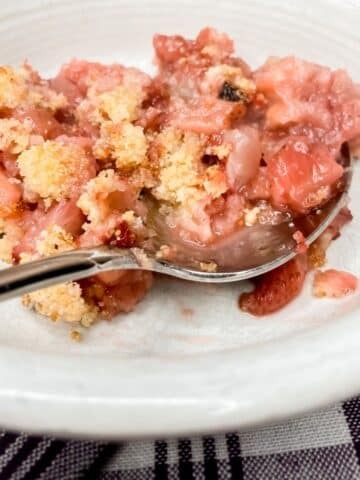 Healthy Strawberry Cobbler
Healthy Strawberry Cobbler Dairy Free Creme BruleePairing with Kidney Friendly Oatmeal Bars
Dairy Free Creme BruleePairing with Kidney Friendly Oatmeal BarsThese are my favorite dishes to serve with Oatmeal Bars Recipes:
 Vegetarian Sloppy Joes
Vegetarian Sloppy Joes Black Bean and Rice Burrito
Black Bean and Rice Burrito Roasted Red Pepper Pesto Pasta
Roasted Red Pepper Pesto Pasta Wild Rice Stuffing
Wild Rice StuffingIf you tried this Recipe or any other recipe on my website, please please leave a star rating and let me know how it goes in the comments below. I love hearing from you!
Recipe PrintHealthy Oatmeal Date Bars Recipe#wprm-recipe-user-rating-0 .wprm-rating-star.wprm-rating-star-full svg * { fill: #343434; }#wprm-recipe-user-rating-0 .wprm-rating-star.wprm-rating-star-33 svg * { fill: url(#wprm-recipe-user-rating-0-33); }#wprm-recipe-user-rating-0 .wprm-rating-star.wprm-rating-star-50 svg * { fill: url(#wprm-recipe-user-rating-0-50); }#wprm-recipe-user-rating-0 .wprm-rating-star.wprm-rating-star-66 svg * { fill: url(#wprm-recipe-user-rating-0-66); }linearGradient#wprm-recipe-user-rating-0-33 stop { stop-color: #343434; }linearGradient#wprm-recipe-user-rating-0-50 stop { stop-color: #343434; }linearGradient#wprm-recipe-user-rating-0-66 stop { stop-color: #343434; }#wprm-recipe-user-rating-0.wprm-user-rating-allowed.wprm-user-rating-not-voted:not(.wprm-user-rating-voting) svg * { fill-opacity: 0.3; }Course Breakfast, Dessert, SnackCuisine AmericanDiet Low Calorie, Low Fat, Low Lactose, Low Salt, VegetarianPrep Time 15 minutes minutesCook Time 40 minutes minutesTotal Time 55 minutes minutesServings 8Calories 295kcalAuthor Mathea Ford, RDN, LD, MBAEquipment1 Casserole Dish1 Large Bowl1 Chef's KnifeIngredientsDate Filling1 cups dried dates pitted and chopped½ cup water2 tablespoon lemon juice1 teaspoon cinnamon1 tablespoon lemon zestCrisp1 ½ cup quick oats1 cup flour½ cup brown sugar1 tablespoon honeyâ
cup melted butter¼ teaspoon baking powderGet ingredients with
PrintHealthy Oatmeal Date Bars Recipe#wprm-recipe-user-rating-0 .wprm-rating-star.wprm-rating-star-full svg * { fill: #343434; }#wprm-recipe-user-rating-0 .wprm-rating-star.wprm-rating-star-33 svg * { fill: url(#wprm-recipe-user-rating-0-33); }#wprm-recipe-user-rating-0 .wprm-rating-star.wprm-rating-star-50 svg * { fill: url(#wprm-recipe-user-rating-0-50); }#wprm-recipe-user-rating-0 .wprm-rating-star.wprm-rating-star-66 svg * { fill: url(#wprm-recipe-user-rating-0-66); }linearGradient#wprm-recipe-user-rating-0-33 stop { stop-color: #343434; }linearGradient#wprm-recipe-user-rating-0-50 stop { stop-color: #343434; }linearGradient#wprm-recipe-user-rating-0-66 stop { stop-color: #343434; }#wprm-recipe-user-rating-0.wprm-user-rating-allowed.wprm-user-rating-not-voted:not(.wprm-user-rating-voting) svg * { fill-opacity: 0.3; }Course Breakfast, Dessert, SnackCuisine AmericanDiet Low Calorie, Low Fat, Low Lactose, Low Salt, VegetarianPrep Time 15 minutes minutesCook Time 40 minutes minutesTotal Time 55 minutes minutesServings 8Calories 295kcalAuthor Mathea Ford, RDN, LD, MBAEquipment1 Casserole Dish1 Large Bowl1 Chef's KnifeIngredientsDate Filling1 cups dried dates pitted and chopped½ cup water2 tablespoon lemon juice1 teaspoon cinnamon1 tablespoon lemon zestCrisp1 ½ cup quick oats1 cup flour½ cup brown sugar1 tablespoon honeyâ
cup melted butter¼ teaspoon baking powderGet ingredients with  InstructionsPreheat oven to 350'FPlace dates, water, lemon juice, cinnamon and lemon zest into a medium saucepan. Bring to a boil. Boil for at least 10 minutes until the dates break down. Use a hand held blender (or regular blender) to puree the dates once cooked so they are smooth.Place oats, flour, brown sugar, honey, butter and baking powder into a medium sized bowl and mix well.Spray an 8x8 in pan and line with parchment paper.Pour half the oat mixture into the bottom of the pan and gently push it down.Pour the date mixture on top and use a spatula to spread it evenly over the bottom crisp.Add remaining oat mixture on top of the date filling and gently press it down.Bake for 35 minutes. Cut into 8 piecesNutritionCalories: 295kcal | Carbohydrates: 52g | Protein: 4g | Fat: 9g | Saturated Fat: 5g | Polyunsaturated Fat: 1g | Monounsaturated Fat: 2g | Trans Fat: 0.3g | Cholesterol: 20mg | Sodium: 80mg | Potassium: 220mg | Fiber: 4g | Sugar: 28g | Vitamin A: 240IU | Vitamin C: 3mg | Calcium: 42mg | Iron: 2mg | Phosphorus: 104mgCheck Out Our Meal Plans For People With Chronic Kidney Disease (CKD)
InstructionsPreheat oven to 350'FPlace dates, water, lemon juice, cinnamon and lemon zest into a medium saucepan. Bring to a boil. Boil for at least 10 minutes until the dates break down. Use a hand held blender (or regular blender) to puree the dates once cooked so they are smooth.Place oats, flour, brown sugar, honey, butter and baking powder into a medium sized bowl and mix well.Spray an 8x8 in pan and line with parchment paper.Pour half the oat mixture into the bottom of the pan and gently push it down.Pour the date mixture on top and use a spatula to spread it evenly over the bottom crisp.Add remaining oat mixture on top of the date filling and gently press it down.Bake for 35 minutes. Cut into 8 piecesNutritionCalories: 295kcal | Carbohydrates: 52g | Protein: 4g | Fat: 9g | Saturated Fat: 5g | Polyunsaturated Fat: 1g | Monounsaturated Fat: 2g | Trans Fat: 0.3g | Cholesterol: 20mg | Sodium: 80mg | Potassium: 220mg | Fiber: 4g | Sugar: 28g | Vitamin A: 240IU | Vitamin C: 3mg | Calcium: 42mg | Iron: 2mg | Phosphorus: 104mgCheck Out Our Meal Plans For People With Chronic Kidney Disease (CKD)The post Healthy Oatmeal Date Bars appeared first on Renal Diet HQ.
January 20, 2025
Kale and Pomegranate Salad
Looking for a fresh and flavorful salad thatâs both delicious and kidney-friendly? This Kale and Pomegranate Salad combines nutrient-rich kale, antioxidant-packed pomegranate seeds, and heart-healthy ingredients like olive oil and pecans, making it a perfect choice for those managing chronic kidney disease (CKD). Itâs a simple yet vibrant dish that supports your kidney health while satisfying your taste buds.
As a Registered Dietitian Nutritionist specializing in chronic kidney disease, I have extensive experience helping individuals manage their kidney health through diet. My approach is rooted in evidence-based practices and a deep understanding of the nutritional needs of those with CKD. This Kale Salad with Pomegranates is designed to support kidney health while offering a flavorful, nutrient-rich meal option.

This Kale and Pomegranate Salad is a perfect addition to a CKD-friendly diet, as it is low in sodium and potassium while providing heart-healthy fats, fiber, and antioxidants. The ingredients, such as kale and pomegranate seeds, offer essential vitamins and nutrients that support kidney function, making this salad both nourishing and delicious for those managing chronic kidney disease.
I love making kidney friendly salads any time of the year, and this is a winter salad that makes the cold weather more bearable. I love this pomegranate kale salad with a nice renal diet chicken recipe, like our chicken with broccoli pasta or our ranch chicken foil packets. Both cook in the oven and make a tasty complement to this dish.
[feast_advanced_jump_to]Ingredients for Pomegranate Kale SaladThis Kale and Pomegranate Salad features a vibrant mix of fresh kale, tangy feta cheese, sweet pomegranate seeds, and crunchy pecans, all brought together with a simple yet flavorful homemade dressing. These wholesome ingredients combine to create a delicious, nutrient-packed dish thatâs both satisfying and kidney-friendly.
 Kale: A nutrient-dense leafy green, rich in vitamins and low in potassium, ideal for a CKD-friendly diet.Feta cheese: Adds tangy flavor and protein with lower sodium compared to other cheeses.Pomegranate seeds: Packed with antioxidants and natural sweetness, supporting heart and kidney health.Chopped pecans: Provide healthy fats, fiber, and a satisfying crunch.Olive oil: A heart-healthy fat with anti-inflammatory benefits.Balsamic vinegar: Enhances flavor without adding extra sodium.Honey: A natural sweetener that avoids refined sugars.Ground mustard powder: Adds mild tanginess and supports digestion.Minced garlic: Offers anti-inflammatory benefits and natural, sodium-free flavor.
Kale: A nutrient-dense leafy green, rich in vitamins and low in potassium, ideal for a CKD-friendly diet.Feta cheese: Adds tangy flavor and protein with lower sodium compared to other cheeses.Pomegranate seeds: Packed with antioxidants and natural sweetness, supporting heart and kidney health.Chopped pecans: Provide healthy fats, fiber, and a satisfying crunch.Olive oil: A heart-healthy fat with anti-inflammatory benefits.Balsamic vinegar: Enhances flavor without adding extra sodium.Honey: A natural sweetener that avoids refined sugars.Ground mustard powder: Adds mild tanginess and supports digestion.Minced garlic: Offers anti-inflammatory benefits and natural, sodium-free flavor.See recipe card for quantities.
How To Make Kale Salad with PomegranatesNow that you have all the fresh ingredients ready, letâs walk through the simple steps to prepare this flavorful salad. With just a few easy instructions, you'll have a healthy and delicious salad in no time!
 After removing stems and ribs from kale, cut into small strips and add to a bowl.
After removing stems and ribs from kale, cut into small strips and add to a bowl. Add all dressing ingredients to a small jar or container with a lid, and shake vigorously to combine.
Add all dressing ingredients to a small jar or container with a lid, and shake vigorously to combine. Add ½ of the dressing to the kale and massage the kale. Massaging the kale is using your hands to gently combine the dressing and kale until it softens slightly - about 2 minutes.
Add ½ of the dressing to the kale and massage the kale. Massaging the kale is using your hands to gently combine the dressing and kale until it softens slightly - about 2 minutes. Add the feta and pomegranate seeds to the bowl with the rest of the dressing and stir to combine.
Add the feta and pomegranate seeds to the bowl with the rest of the dressing and stir to combine.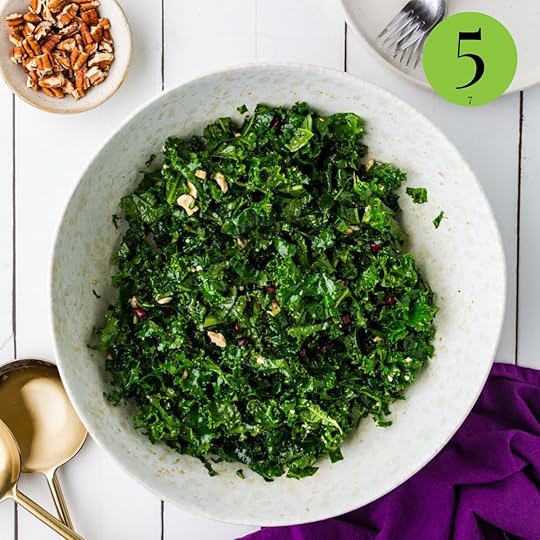
5. Split into 2 servings and sprinkle each salad with pecans.
Hint: To make this salad ahead of time, store the dressing separately to keep the kale fresh and crisp until serving.
SubstitutionsFor those managing chronic kidney disease, making small ingredient swaps can help tailor this salad to your dietary needs. Here are some CKD-friendly substitutions:
Honey Swap: If you prefer to reduce sugar intake, you can replace the honey with a small amount of agave syrup or a sugar-free sweetener like stevia.Pecans Substitute: Swap chopped pecans for slivered almonds or sunflower seeds for a different crunch while maintaining a healthy fat profile.Olive Oil Alternative: Use avocado oil instead of olive oil for a different source of healthy fats, with a mild flavor that pairs well with the other ingredients. Variations
VariationsThis Kale and Pomegranate Salad can be easily adapted to suit different tastes and preferences while keeping it kidney-friendly. Here are a few variations to make it even more versatile:
Add a Protein: Top the salad with a kidney-friendly protein, like grilled chicken or tofu, to make it a more filling main dish.Add More Veggies: For added nutrients, try incorporating cucumber, bell peppers, or carrots into the salad for extra crunch and flavor.Swap the Cheese: If you need a lower-sodium option, consider using a reduced-sodium feta or omit the cheese entirely for a lighter salad.Storage of Pomegranate Kale SaladTo keep your salad fresh, store it in an airtight container in the refrigerator for up to 2 days. If youâve already added the dressing, the kale will soften over time, so itâs best to store the dressing separately and toss it with the salad just before serving. For longer storage, keep the pomegranate seeds and pecans in separate containers to prevent them from becoming soggy. This salad is best enjoyed fresh, but it can still be a convenient and tasty option for meal prep!
Yes, you can prepare the salad ingredients ahead of time and store them separately. Keep the kale, pomegranate seeds, and feta cheese in airtight containers in the fridge, and store the dressing in a separate jar. When you're ready to serve, simply toss everything together for a fresh and flavorful salad.
How can I make this salad more filling?To make the salad more substantial, consider adding a kidney-friendly protein, such as grilled chicken, salmon, or tofu. These additions will provide extra protein and make the salad a complete meal.
Can I use a different type of vinegar for the dressing?Absolutely! While balsamic vinegar adds a rich, slightly sweet flavor, you can substitute it with apple cider vinegar, red wine vinegar, or even lemon juice for a different taste. Just keep in mind that each type of vinegar will bring its own flavor profile to the dish.
Other Kidney Friendly Salad RecipesLooking for other recipes like this? Try these:
 Kale and Pomegranate Salad
Kale and Pomegranate Salad Hawaiian Chicken Salad
Hawaiian Chicken Salad Corn Pasta Salad
Corn Pasta Salad Cornbread SaladPairing with Kale Salad with Pomegranates
Cornbread SaladPairing with Kale Salad with PomegranatesThese are my favorite dishes to serve with this winter salad:
 Chicken and Broccoli with Cashews
Chicken and Broccoli with Cashews Chicken and Broccoli Pasta Bake
Chicken and Broccoli Pasta Bake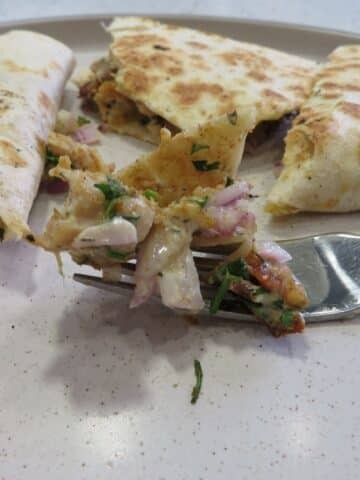 Chicken Bacon Ranch Quesadilla
Chicken Bacon Ranch Quesadilla Roasted Cornish Hens
Roasted Cornish HensIf you tried this Recipe or any other recipe on my website, please please leave a star rating and let me know how it goes in the comments below. I love hearing from you!
Recipe PrintPomegranate Kale Salad Recipe#wprm-recipe-user-rating-0 .wprm-rating-star.wprm-rating-star-full svg * { fill: #343434; }#wprm-recipe-user-rating-0 .wprm-rating-star.wprm-rating-star-33 svg * { fill: url(#wprm-recipe-user-rating-0-33); }#wprm-recipe-user-rating-0 .wprm-rating-star.wprm-rating-star-50 svg * { fill: url(#wprm-recipe-user-rating-0-50); }#wprm-recipe-user-rating-0 .wprm-rating-star.wprm-rating-star-66 svg * { fill: url(#wprm-recipe-user-rating-0-66); }linearGradient#wprm-recipe-user-rating-0-33 stop { stop-color: #343434; }linearGradient#wprm-recipe-user-rating-0-50 stop { stop-color: #343434; }linearGradient#wprm-recipe-user-rating-0-66 stop { stop-color: #343434; }#wprm-recipe-user-rating-0.wprm-user-rating-allowed.wprm-user-rating-not-voted:not(.wprm-user-rating-voting) svg * { fill-opacity: 0.3; }Course Appetizer, Salad, Side DishCuisine AmericanDiet Diabetic, Low Fat, Low Salt, Vegan, VegetarianPrep Time 15 minutes minutesServings 2Calories 343kcalAuthor Mathea Ford, RDN, LD, MBAEquipment1 Large Bowl1 Chef's KnifeIngredientsSalad mix4 cups kale stems and ribs removed, rinsed and dried¼ cup feta cheese½ cup pomegranate seeds about 1 small pomegranate1 tablespoon chopped pecansDressing3 tablespoon olive oil1 ½ tablespoon balsamic vinegar1 teaspoon honey½ teaspoon ground mustard powder½ teaspoon minced garlicGet ingredients with
PrintPomegranate Kale Salad Recipe#wprm-recipe-user-rating-0 .wprm-rating-star.wprm-rating-star-full svg * { fill: #343434; }#wprm-recipe-user-rating-0 .wprm-rating-star.wprm-rating-star-33 svg * { fill: url(#wprm-recipe-user-rating-0-33); }#wprm-recipe-user-rating-0 .wprm-rating-star.wprm-rating-star-50 svg * { fill: url(#wprm-recipe-user-rating-0-50); }#wprm-recipe-user-rating-0 .wprm-rating-star.wprm-rating-star-66 svg * { fill: url(#wprm-recipe-user-rating-0-66); }linearGradient#wprm-recipe-user-rating-0-33 stop { stop-color: #343434; }linearGradient#wprm-recipe-user-rating-0-50 stop { stop-color: #343434; }linearGradient#wprm-recipe-user-rating-0-66 stop { stop-color: #343434; }#wprm-recipe-user-rating-0.wprm-user-rating-allowed.wprm-user-rating-not-voted:not(.wprm-user-rating-voting) svg * { fill-opacity: 0.3; }Course Appetizer, Salad, Side DishCuisine AmericanDiet Diabetic, Low Fat, Low Salt, Vegan, VegetarianPrep Time 15 minutes minutesServings 2Calories 343kcalAuthor Mathea Ford, RDN, LD, MBAEquipment1 Large Bowl1 Chef's KnifeIngredientsSalad mix4 cups kale stems and ribs removed, rinsed and dried¼ cup feta cheese½ cup pomegranate seeds about 1 small pomegranate1 tablespoon chopped pecansDressing3 tablespoon olive oil1 ½ tablespoon balsamic vinegar1 teaspoon honey½ teaspoon ground mustard powder½ teaspoon minced garlicGet ingredients with  InstructionsAfter removing stems and ribs from kale, cut into small strips and add to a bowl.Add all dressing ingredients to a small jar or container with a lid, and shake vigorously to combine.Add ½ of the dressing to the kale and massage the kale. Massaging the kale is using your hands to gently combine the dressing and kale until it softens slightly - about 2 minutes.Add the feta and pomegranate seeds to the bowl with the rest of the dressing and stir to combine.Split into 2 servings and sprinkle each salad with pecans.Videohttps://youtu.be/sIOSvFQD89UNutritionCalories: 343kcal | Carbohydrates: 16g | Protein: 5g | Fat: 30g | Saturated Fat: 6g | Polyunsaturated Fat: 4g | Monounsaturated Fat: 18g | Cholesterol: 17mg | Sodium: 241mg | Potassium: 297mg | Fiber: 4g | Sugar: 11g | Vitamin A: 4278IU | Vitamin C: 44mg | Vitamin D: 0.1µg | Calcium: 213mg | Iron: 1mg | Phosphorus: 123mgCheck Out Our Meal Plans For People With Chronic Kidney Disease (CKD)
InstructionsAfter removing stems and ribs from kale, cut into small strips and add to a bowl.Add all dressing ingredients to a small jar or container with a lid, and shake vigorously to combine.Add ½ of the dressing to the kale and massage the kale. Massaging the kale is using your hands to gently combine the dressing and kale until it softens slightly - about 2 minutes.Add the feta and pomegranate seeds to the bowl with the rest of the dressing and stir to combine.Split into 2 servings and sprinkle each salad with pecans.Videohttps://youtu.be/sIOSvFQD89UNutritionCalories: 343kcal | Carbohydrates: 16g | Protein: 5g | Fat: 30g | Saturated Fat: 6g | Polyunsaturated Fat: 4g | Monounsaturated Fat: 18g | Cholesterol: 17mg | Sodium: 241mg | Potassium: 297mg | Fiber: 4g | Sugar: 11g | Vitamin A: 4278IU | Vitamin C: 44mg | Vitamin D: 0.1µg | Calcium: 213mg | Iron: 1mg | Phosphorus: 123mgCheck Out Our Meal Plans For People With Chronic Kidney Disease (CKD)The post Kale and Pomegranate Salad appeared first on Renal Diet HQ.



